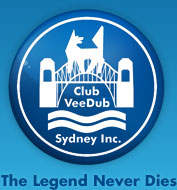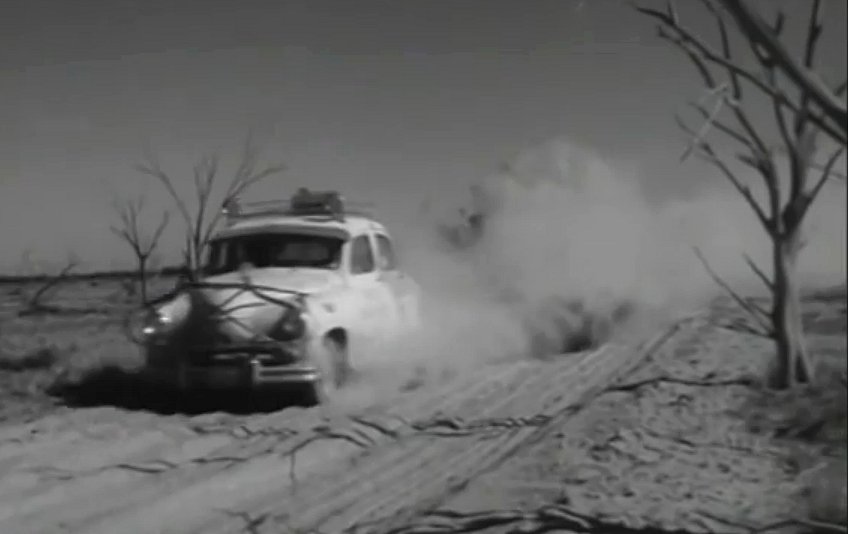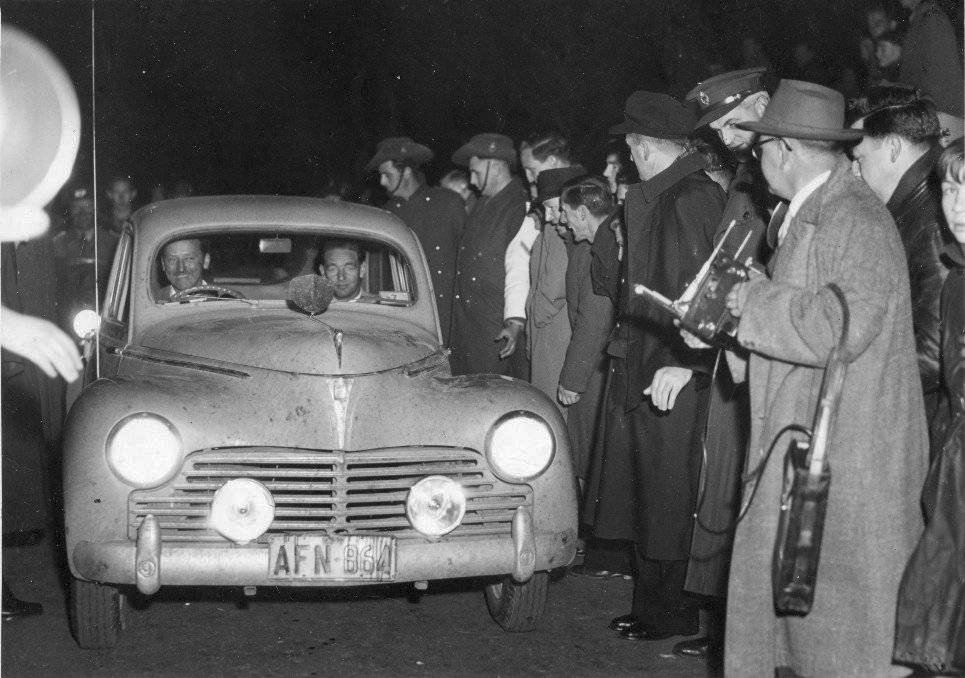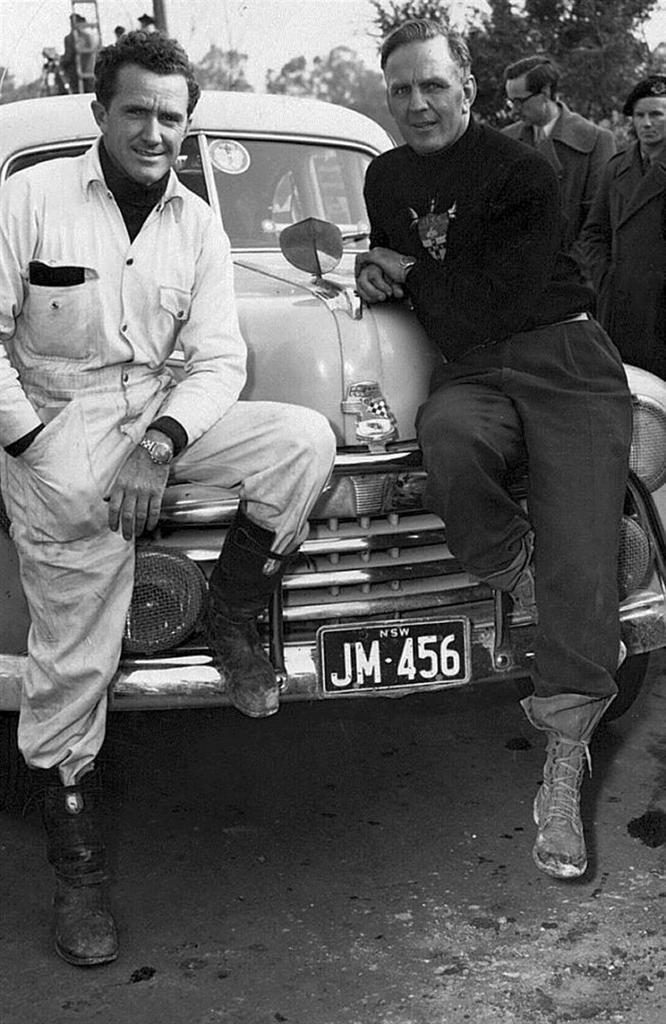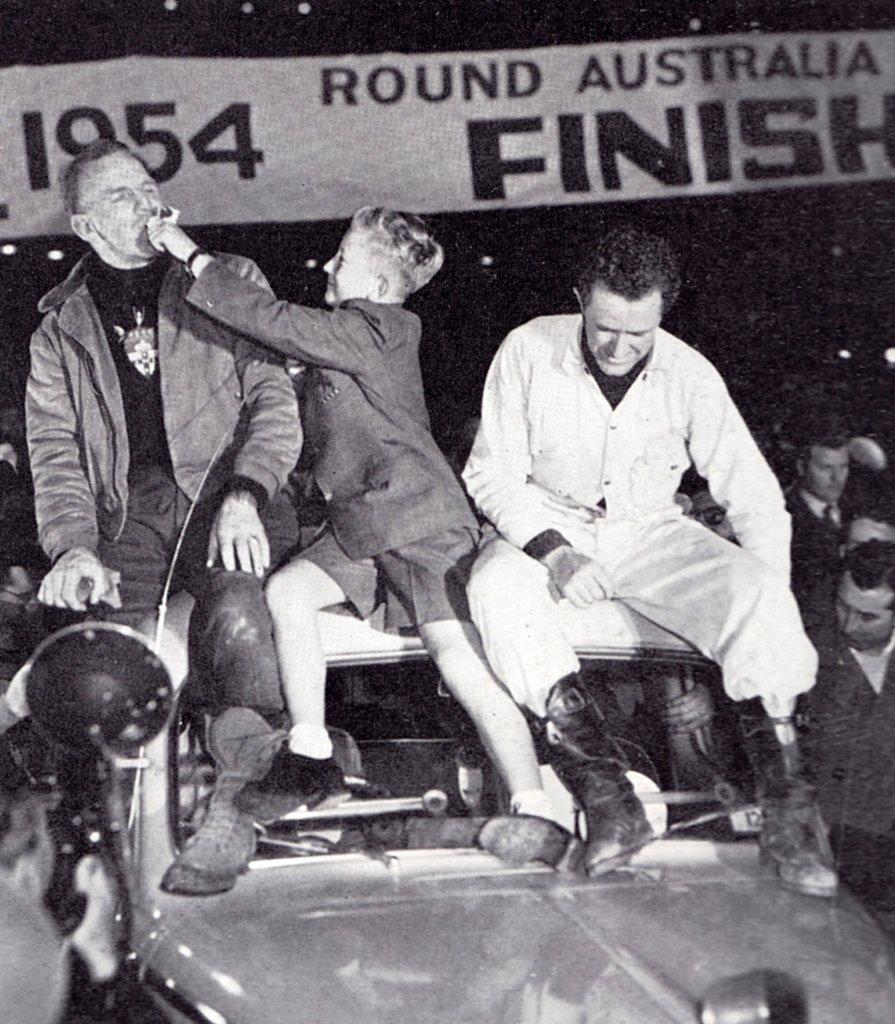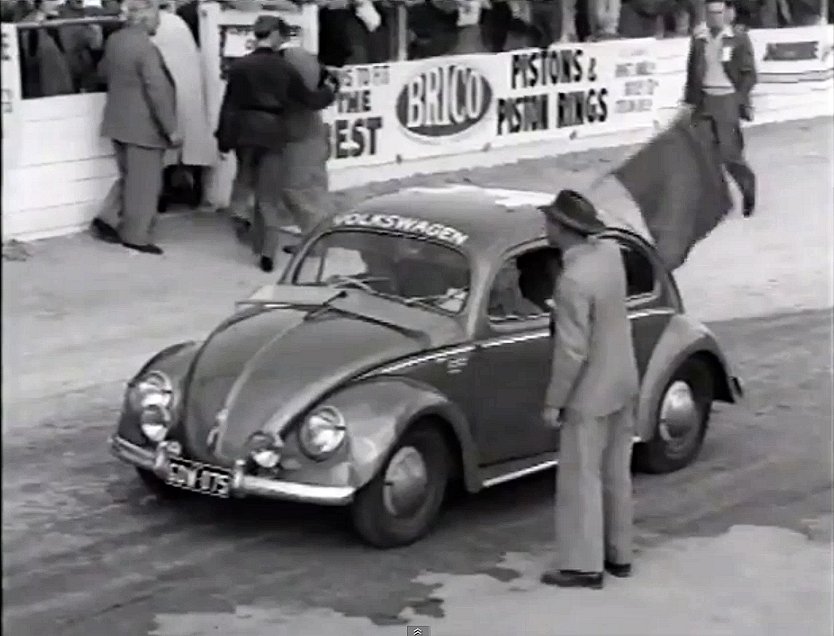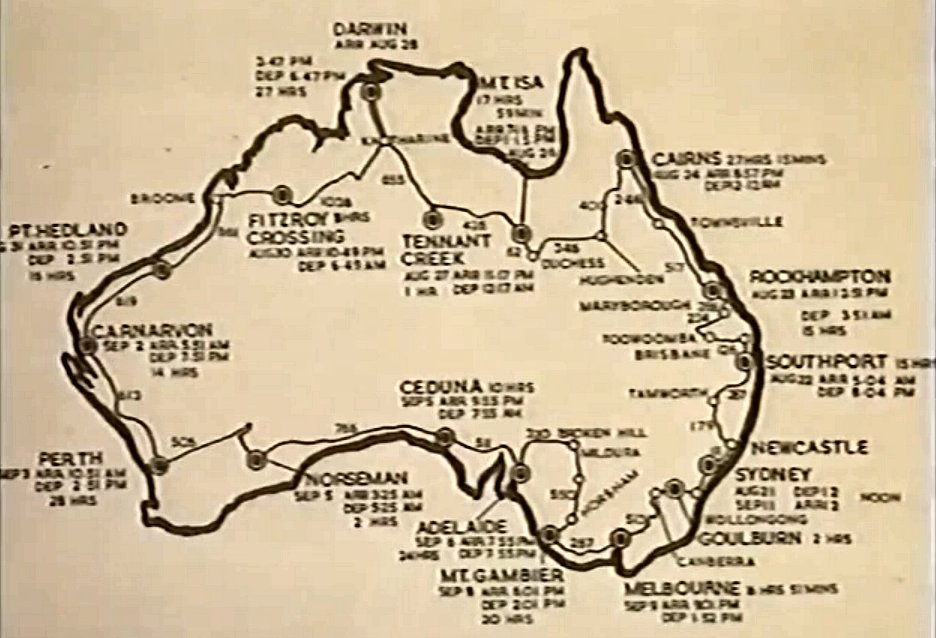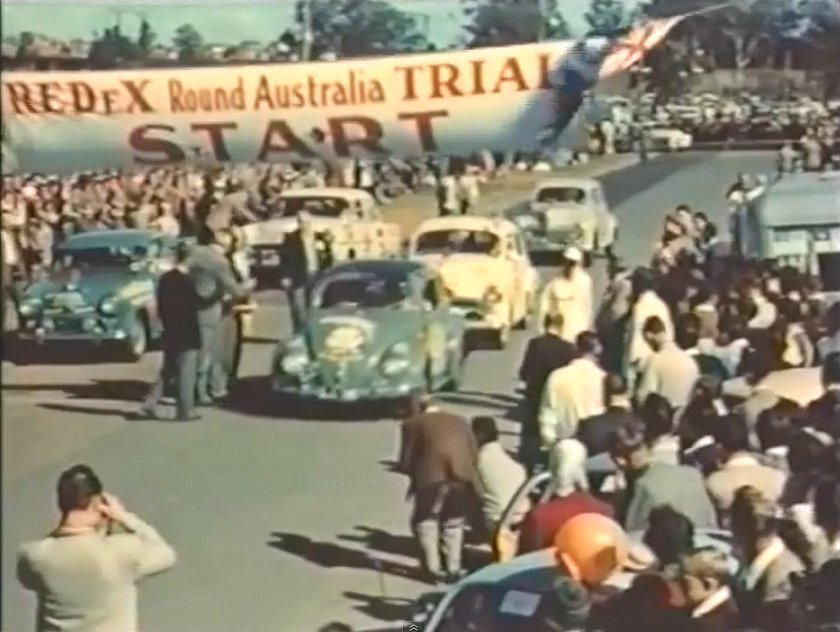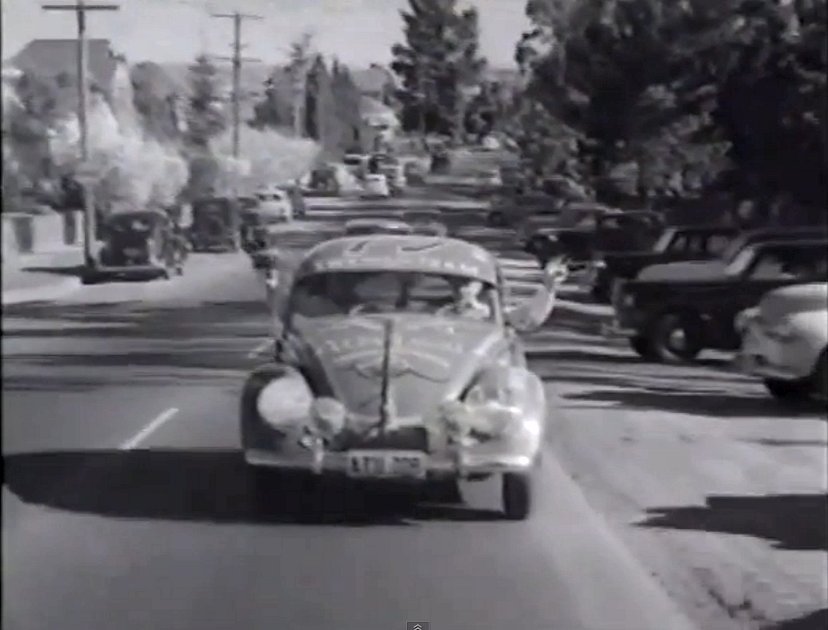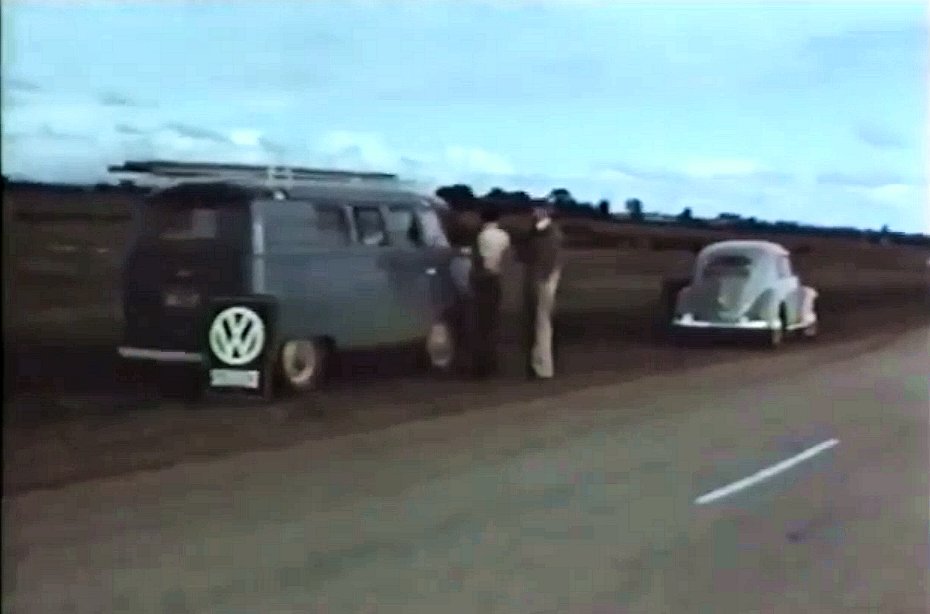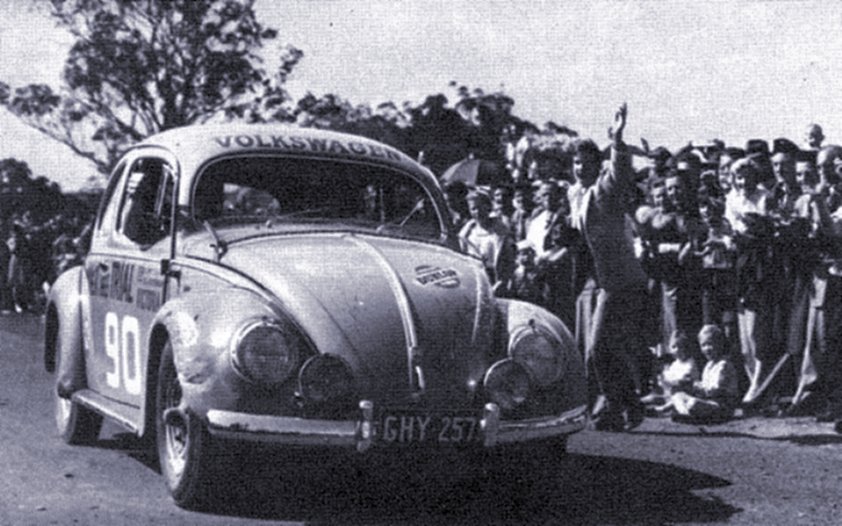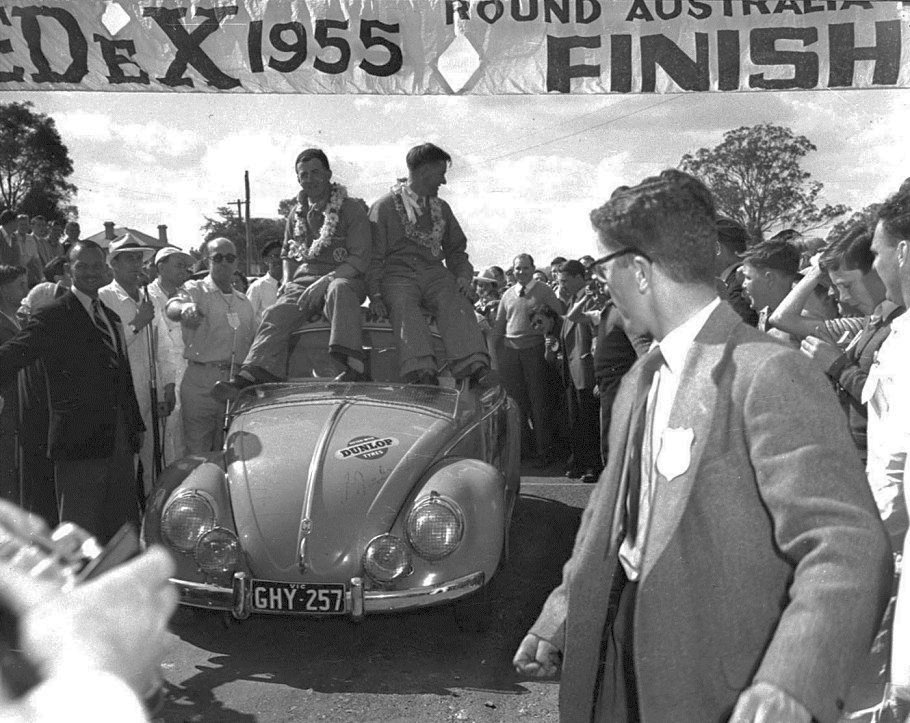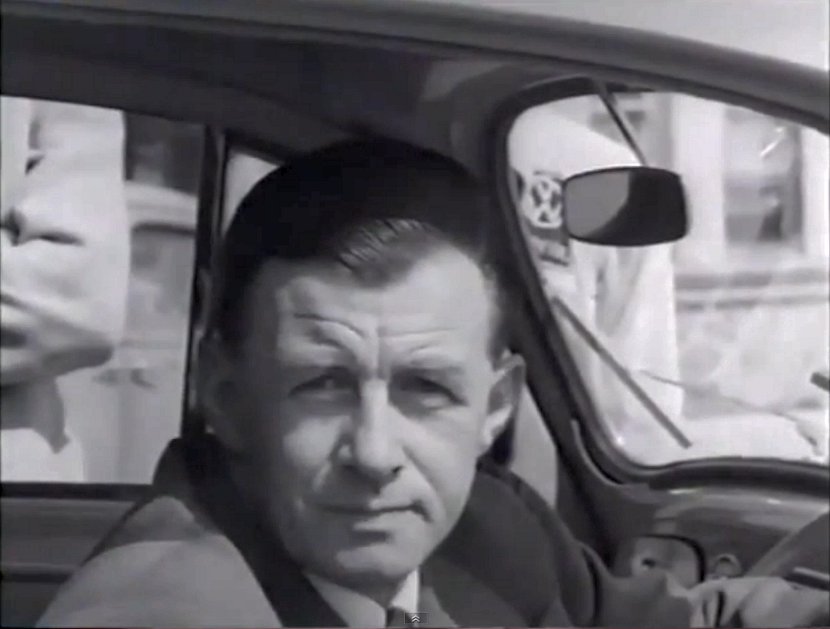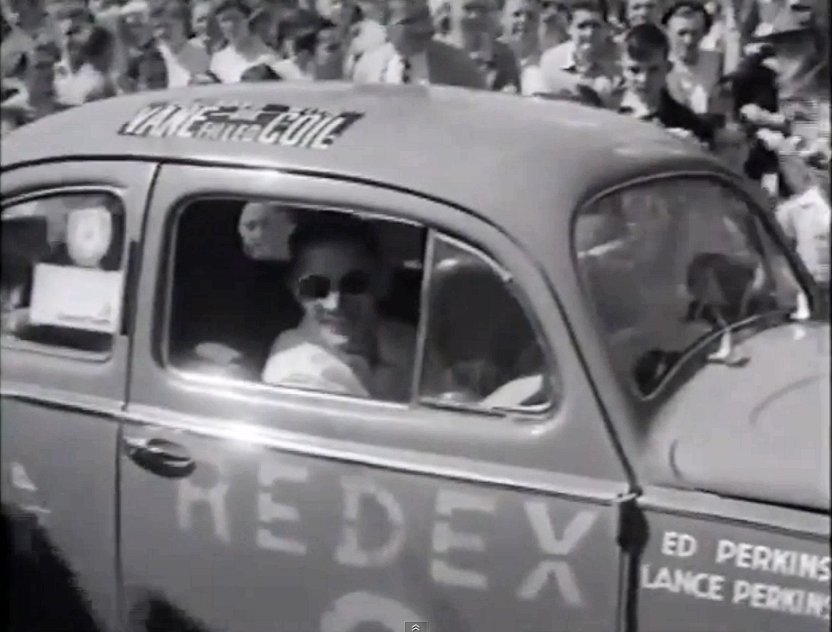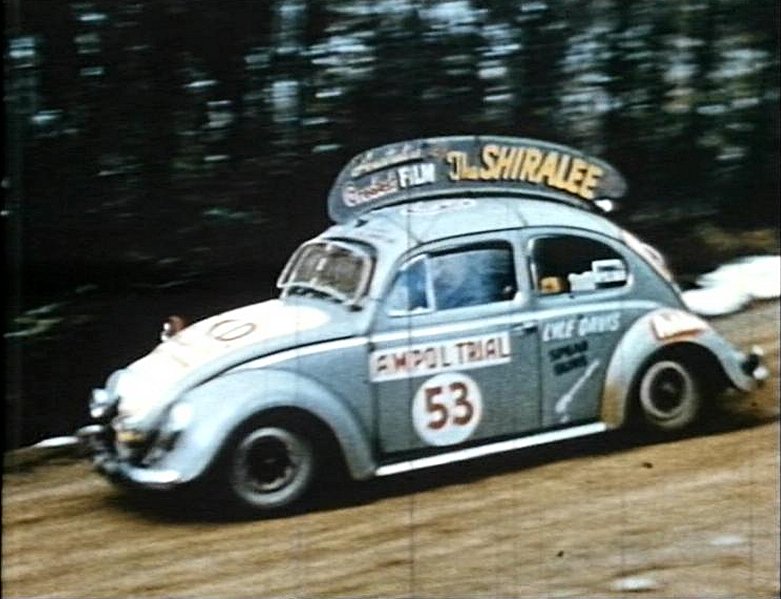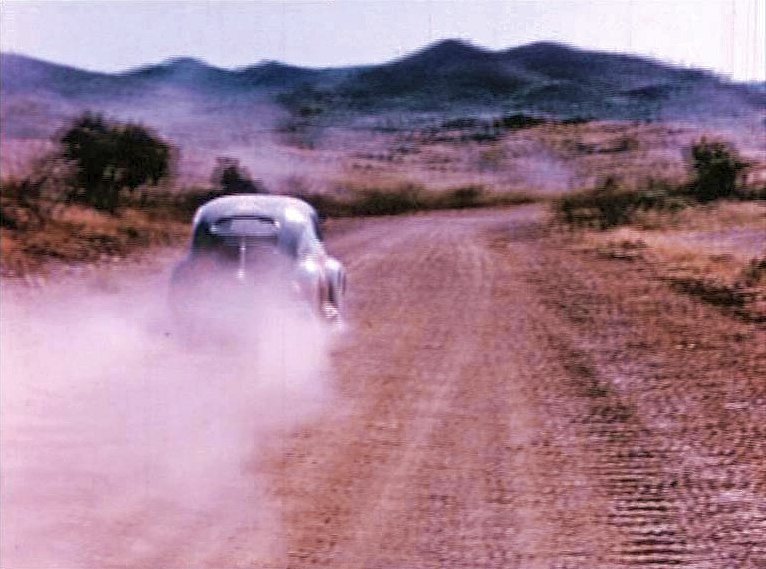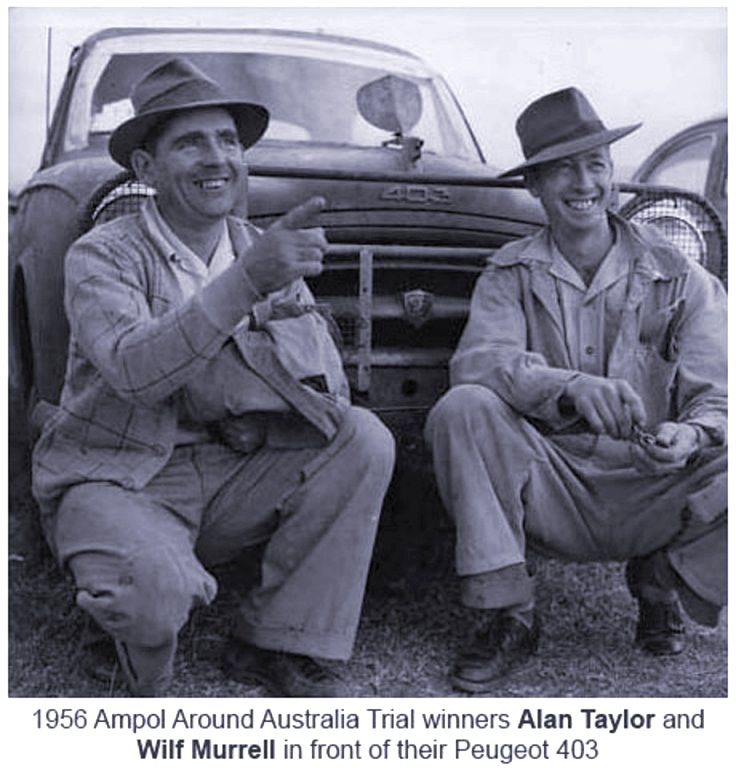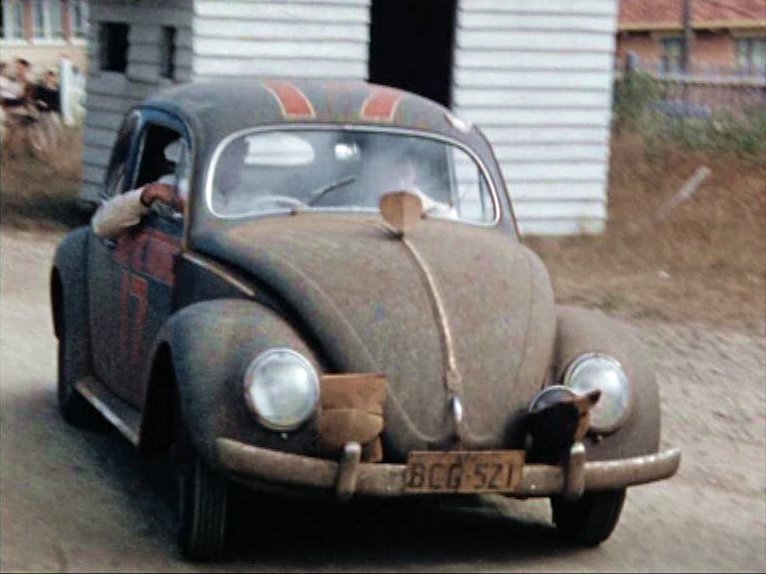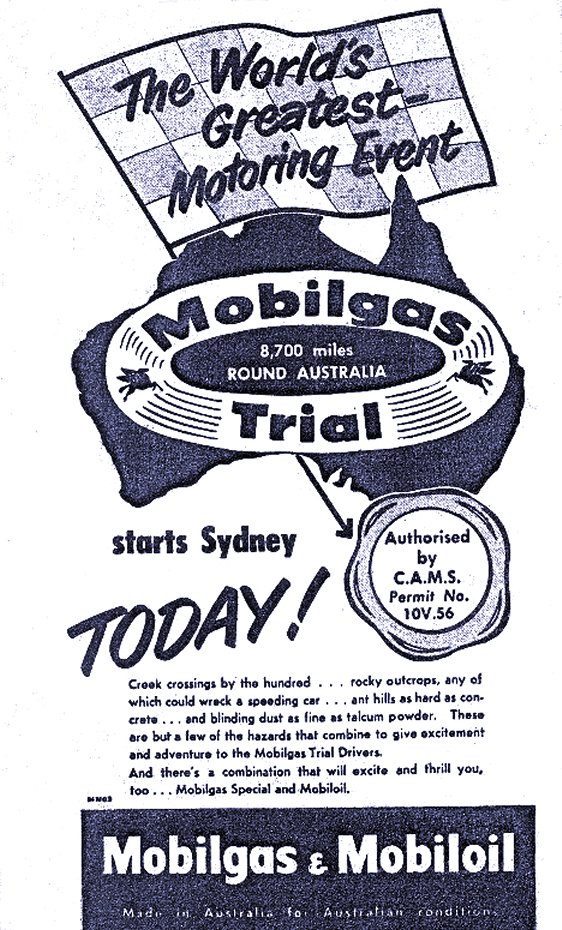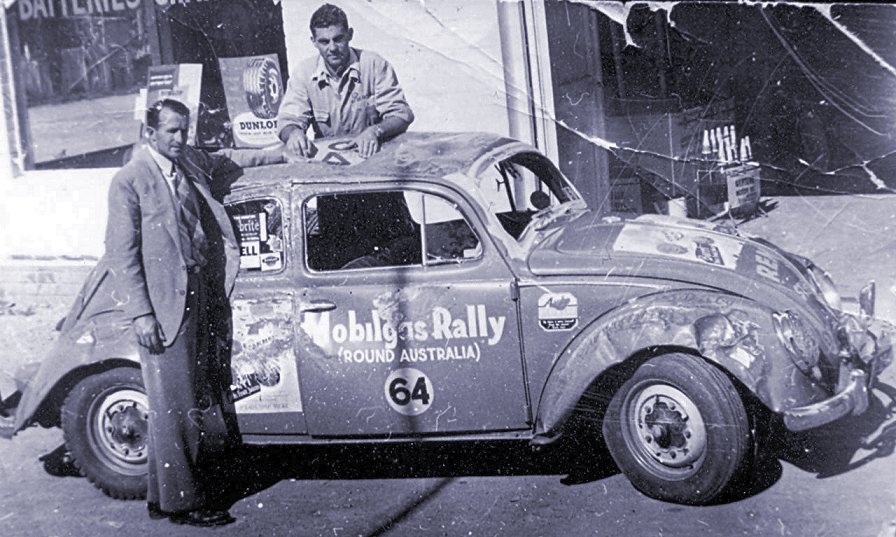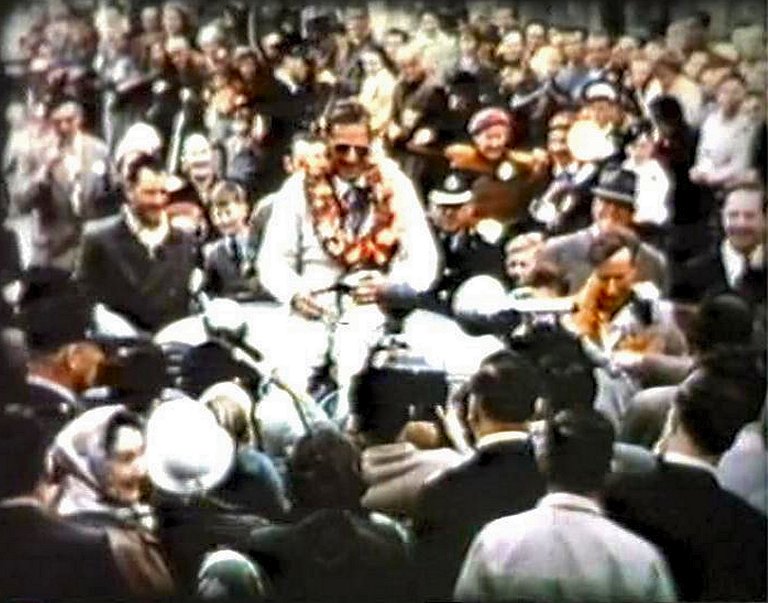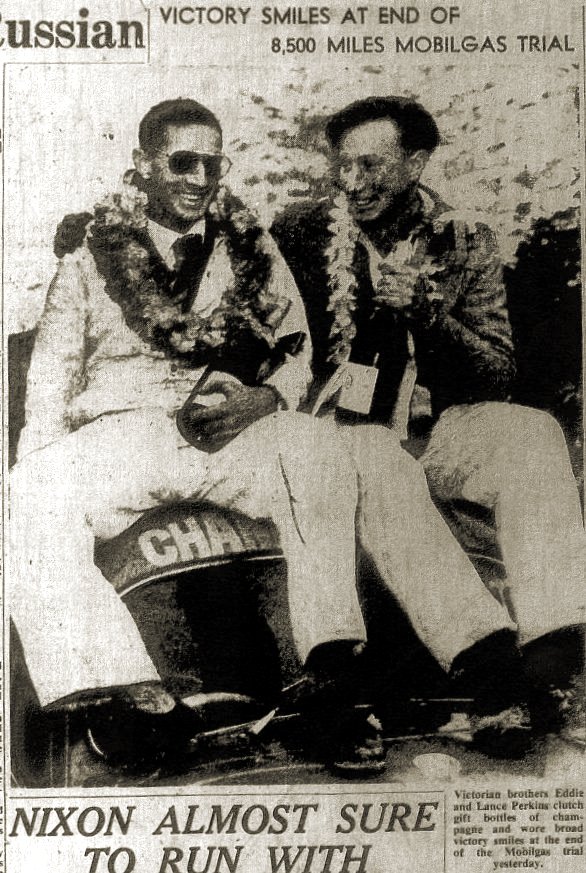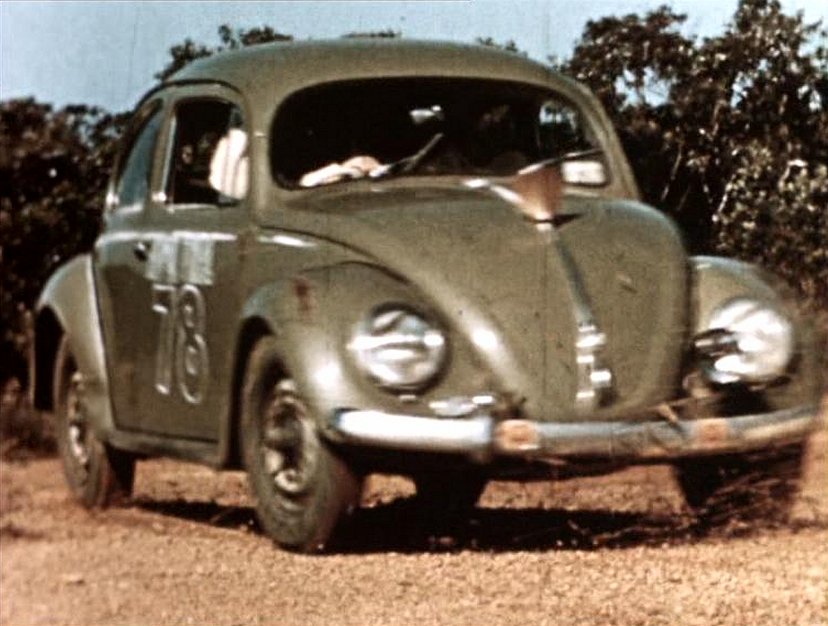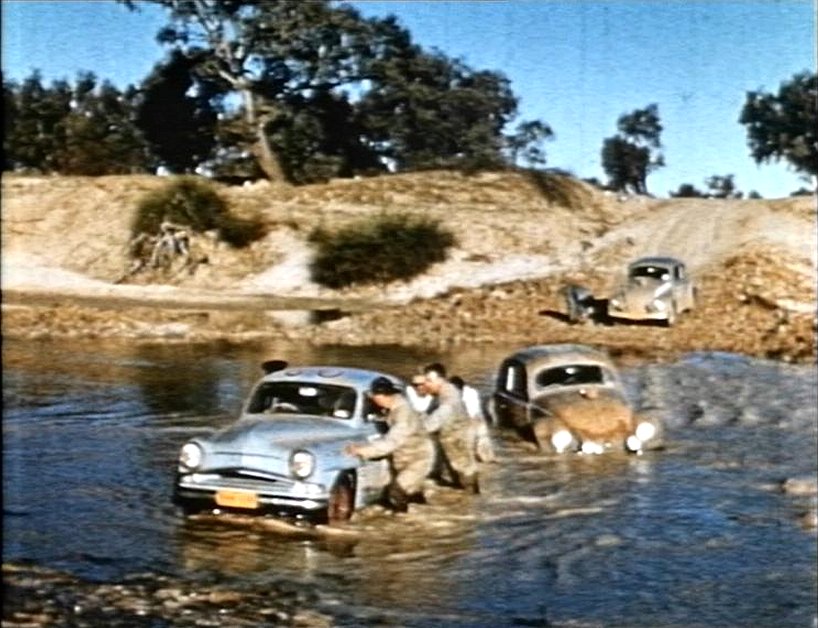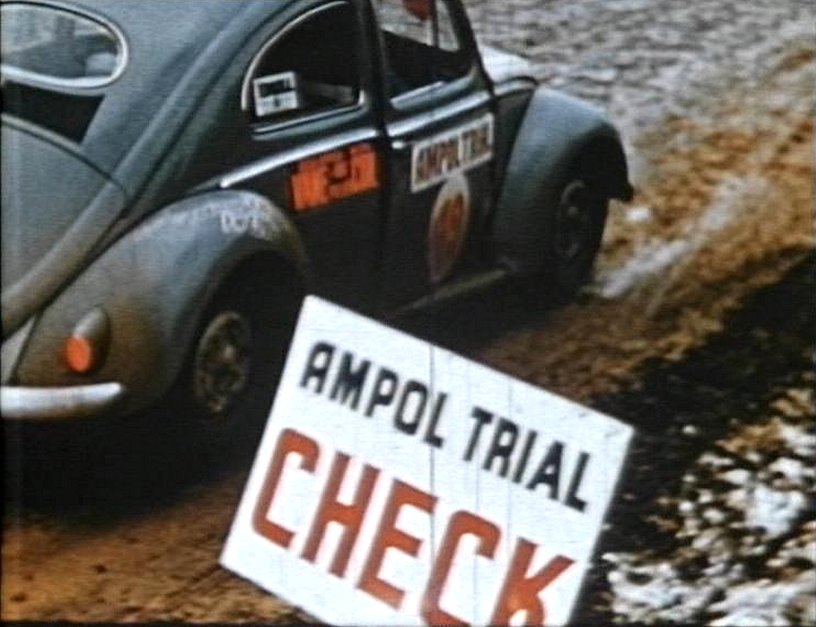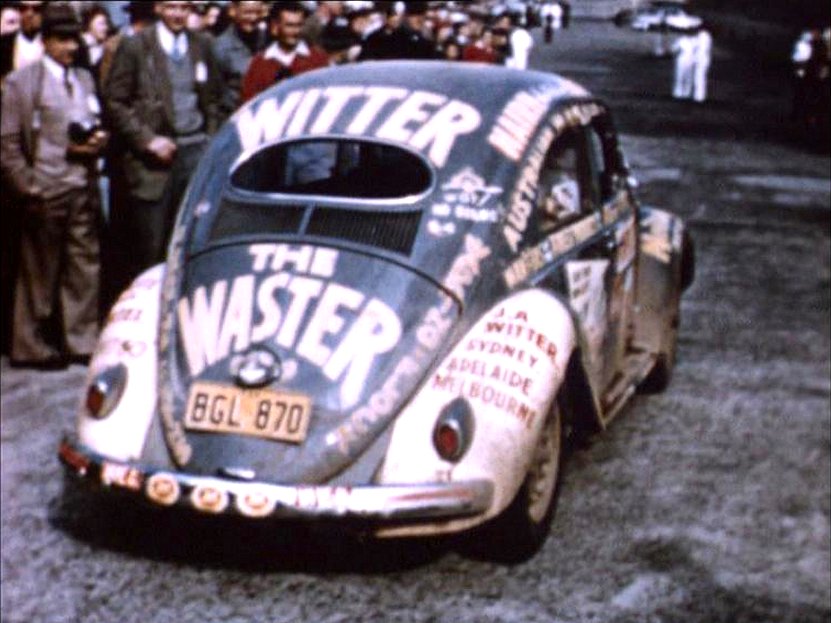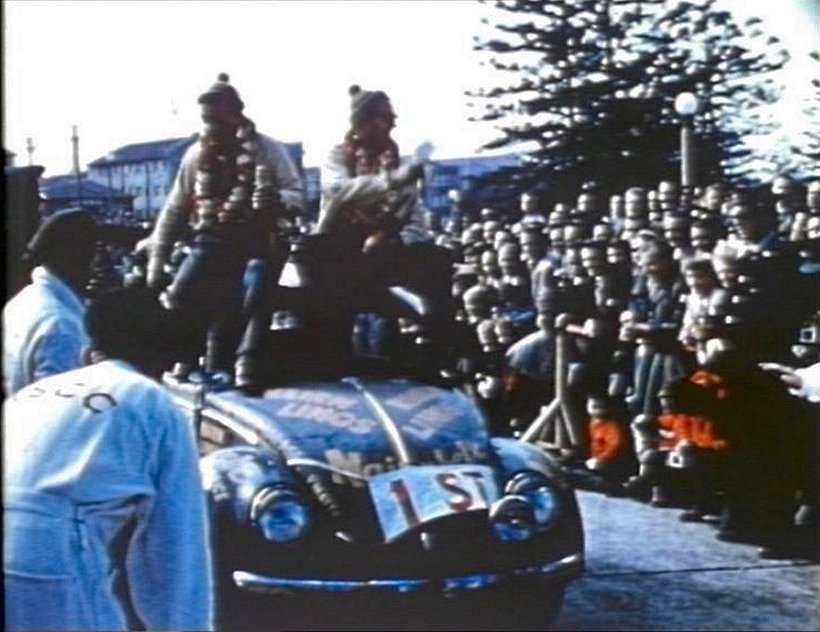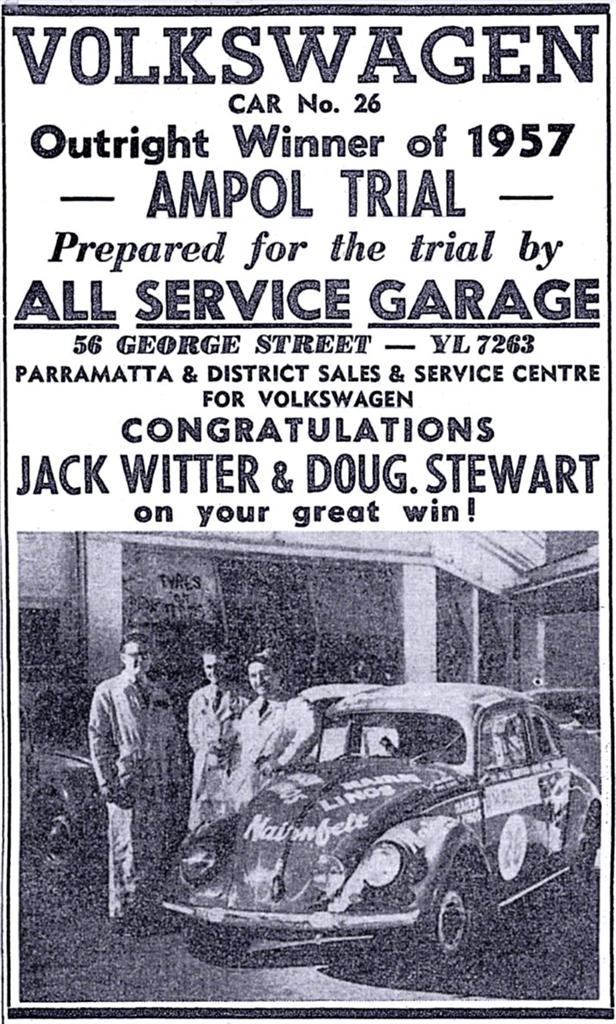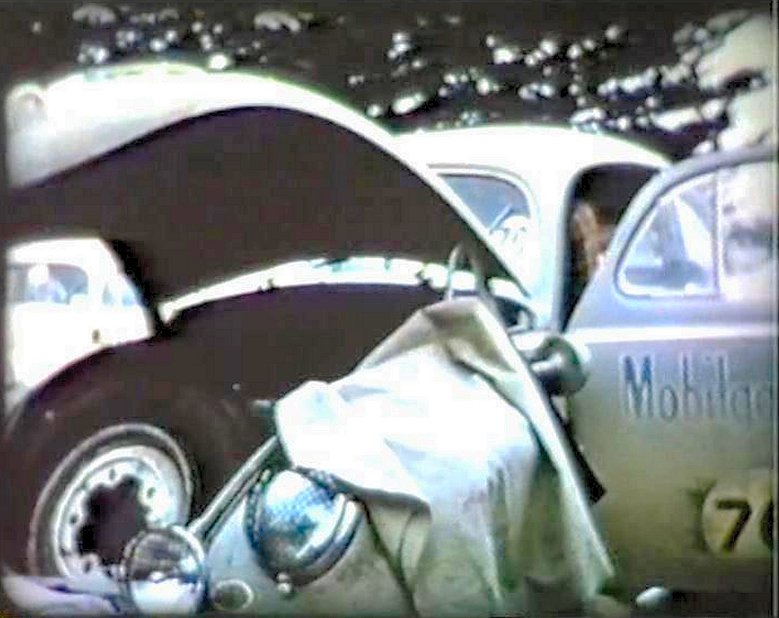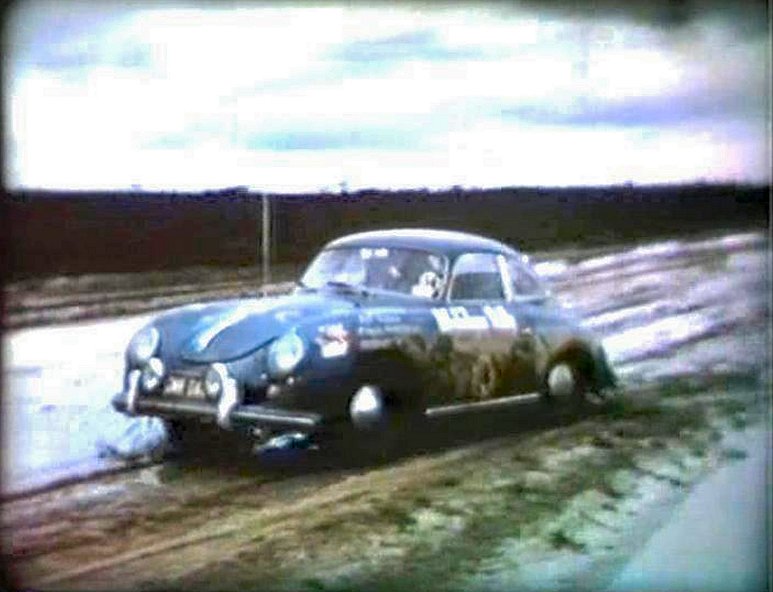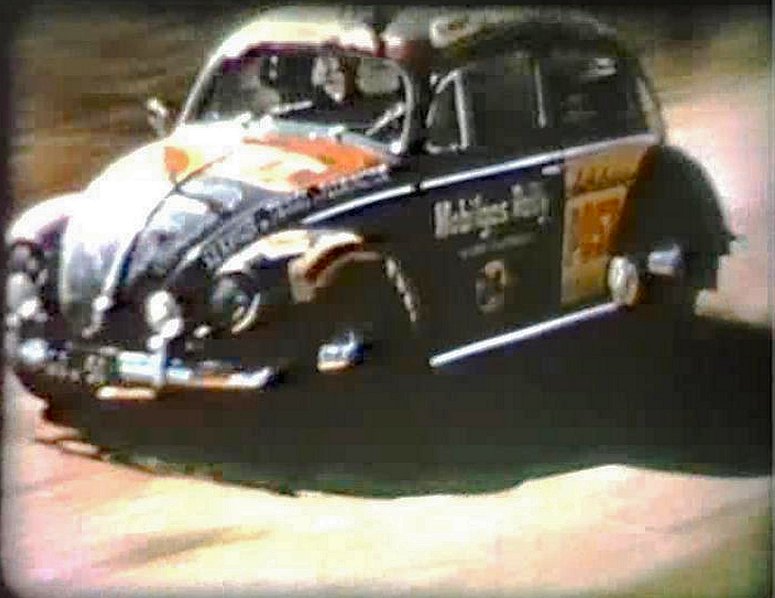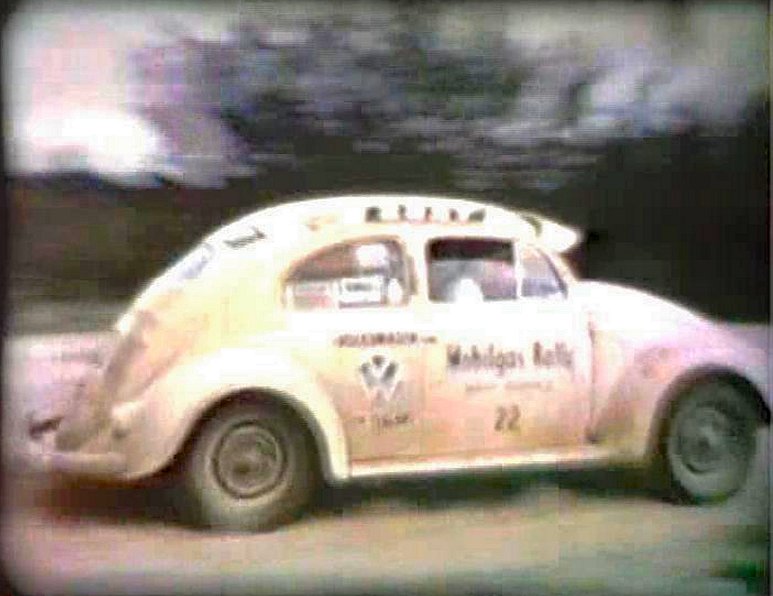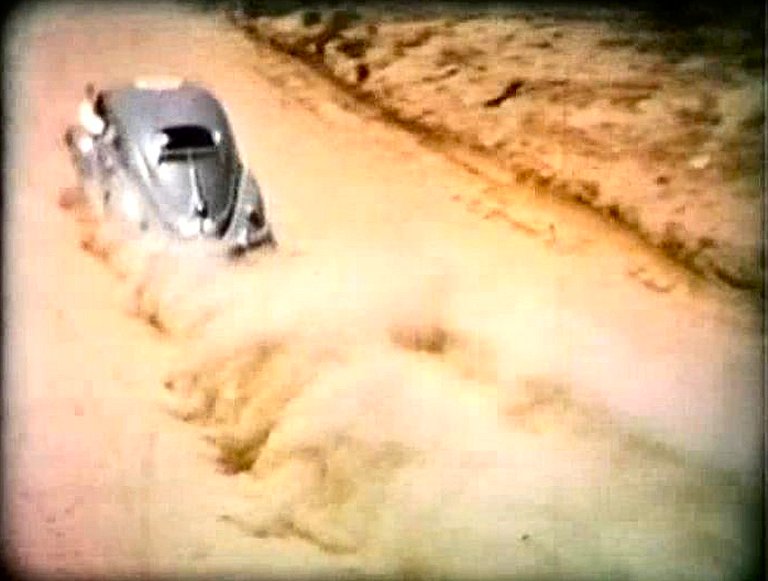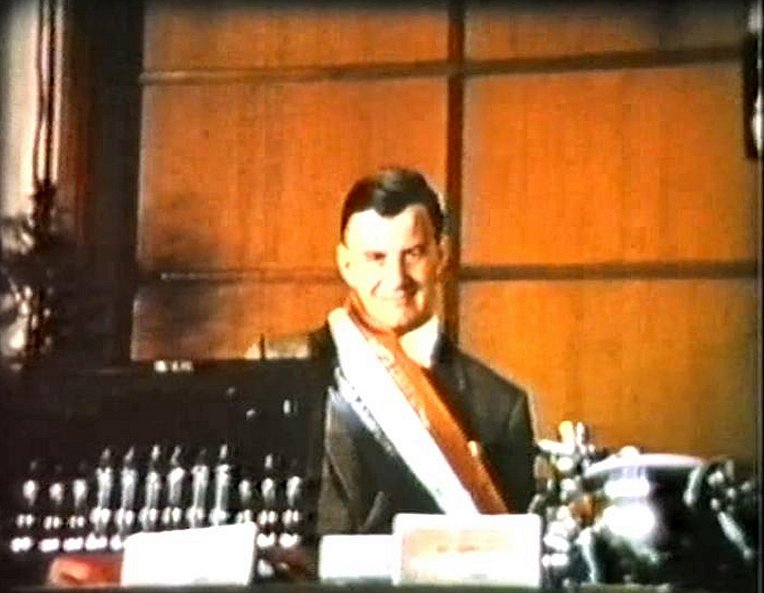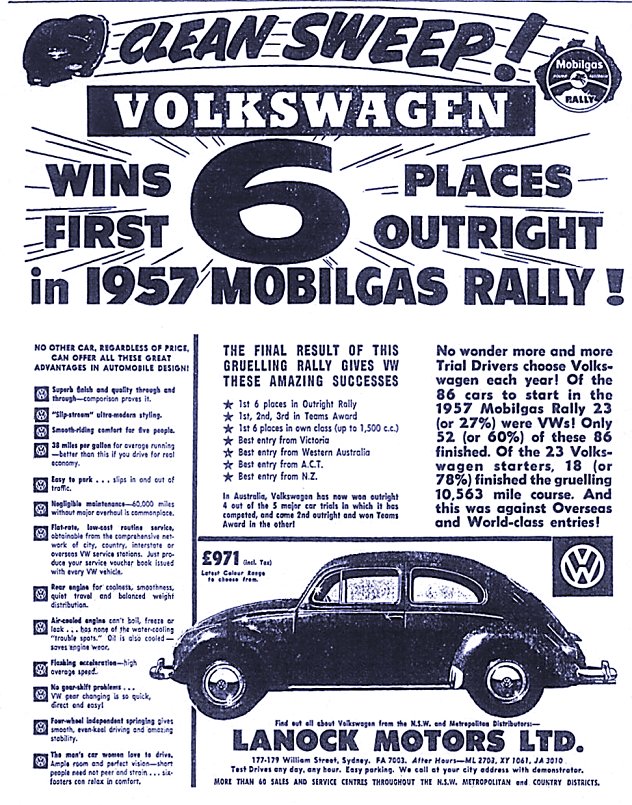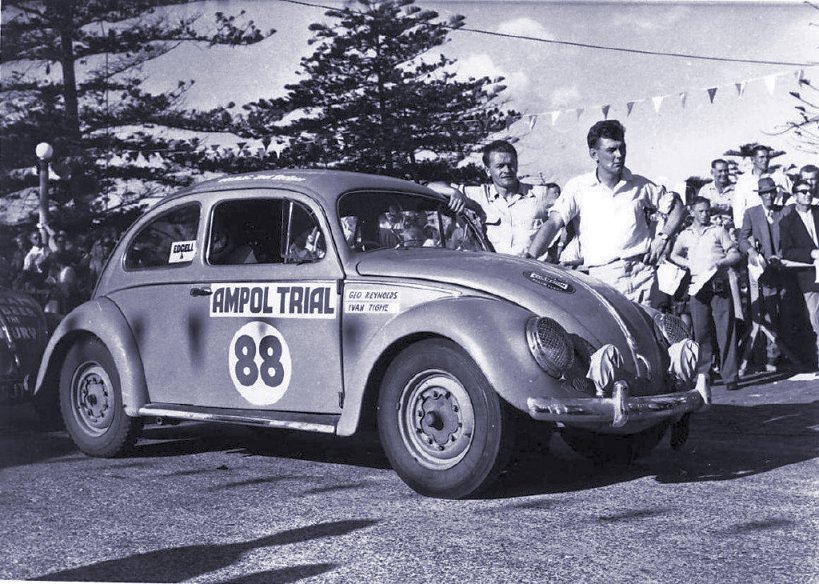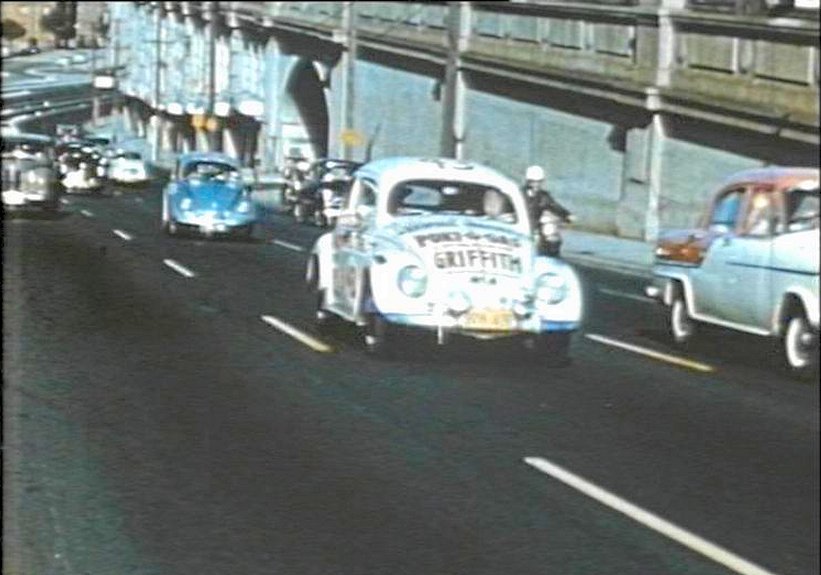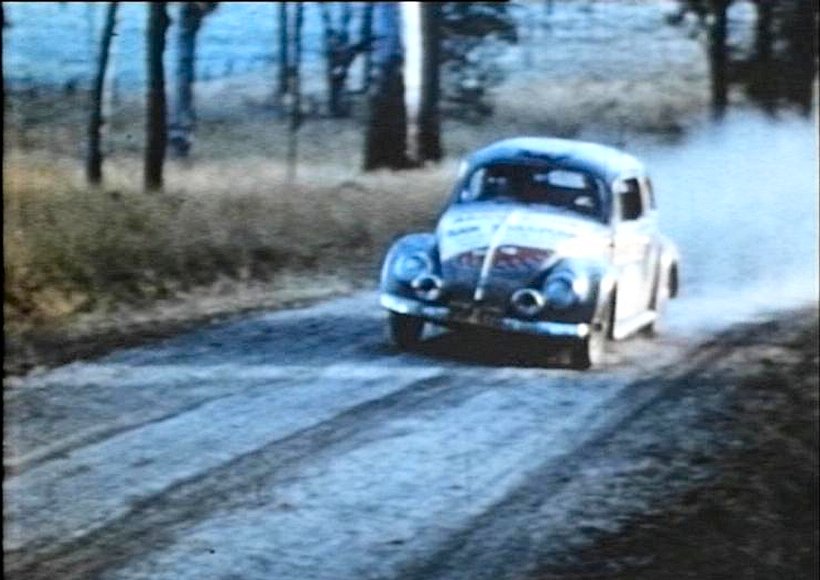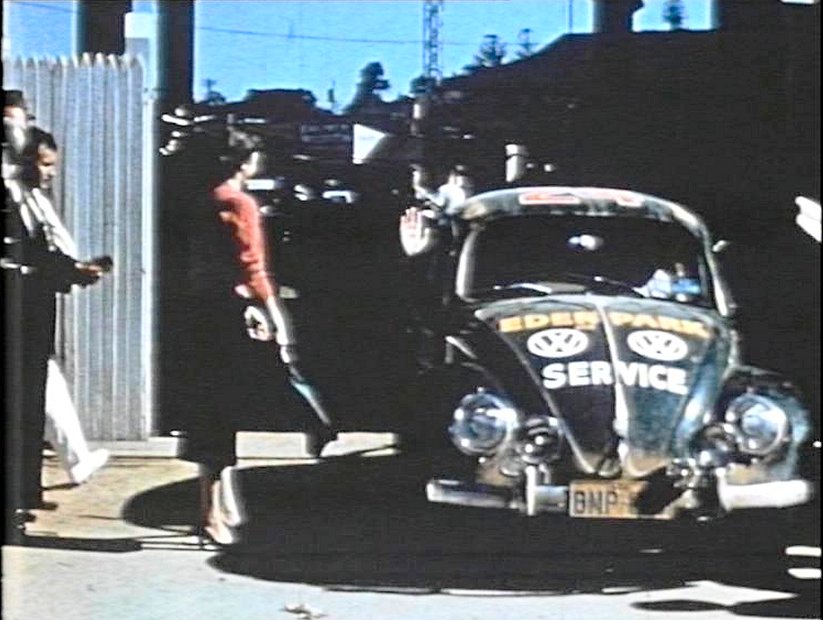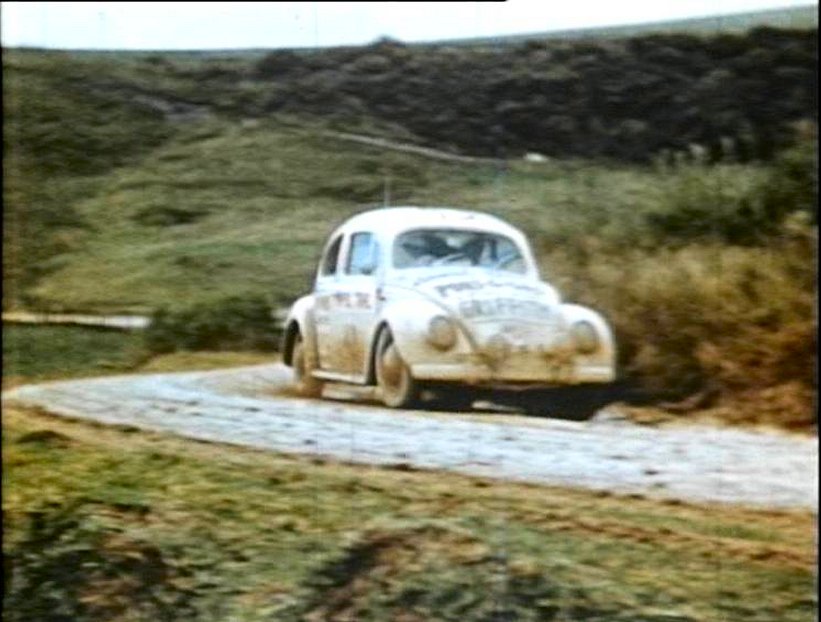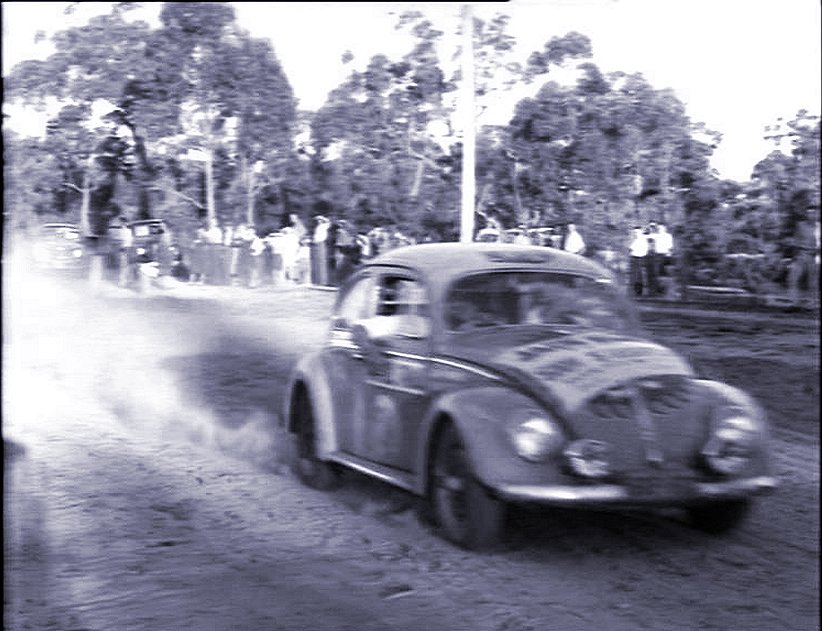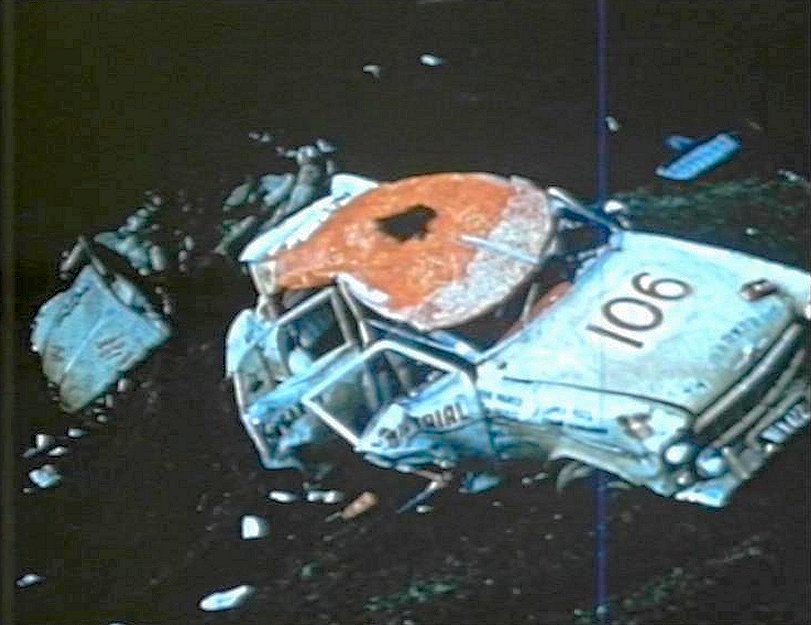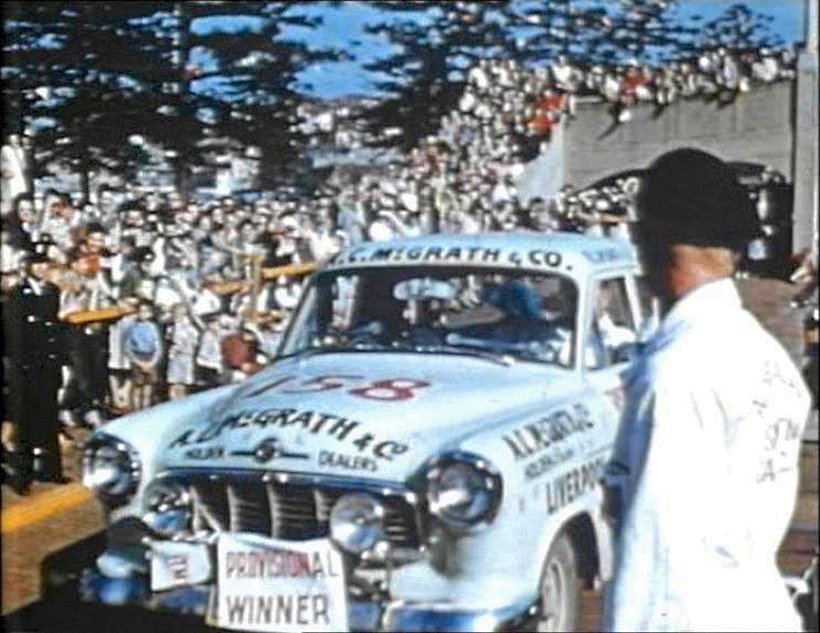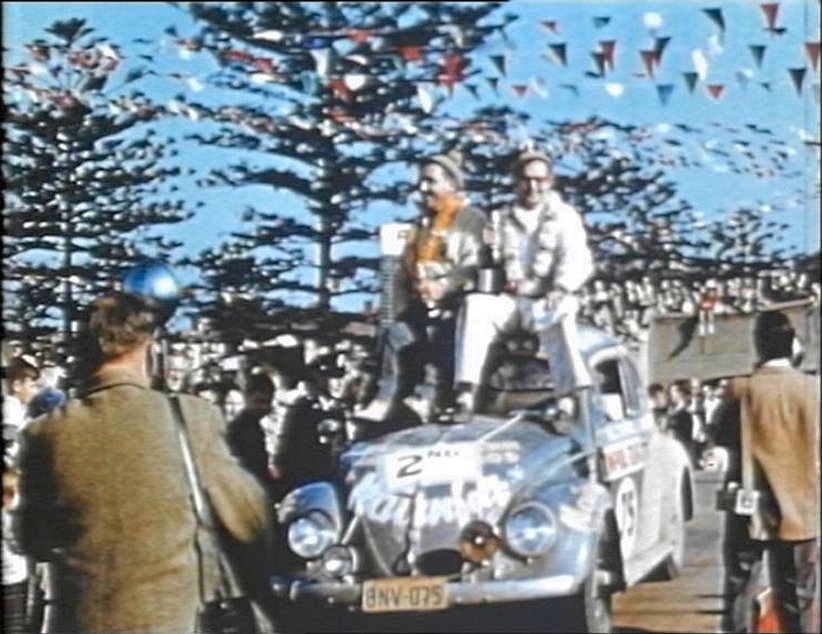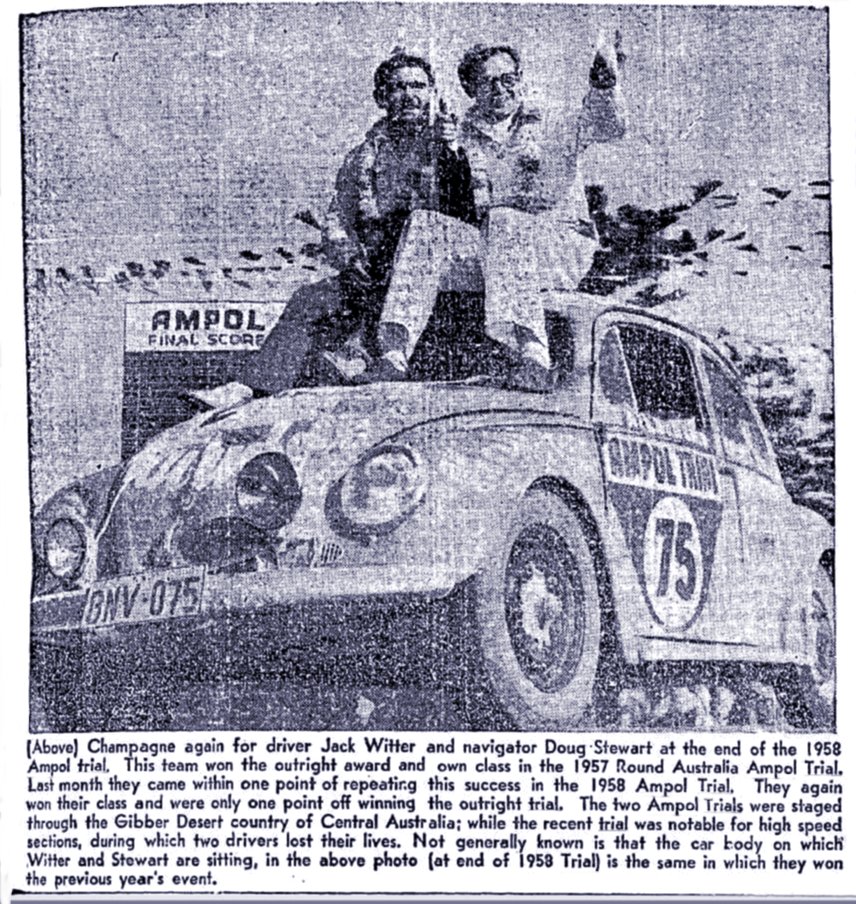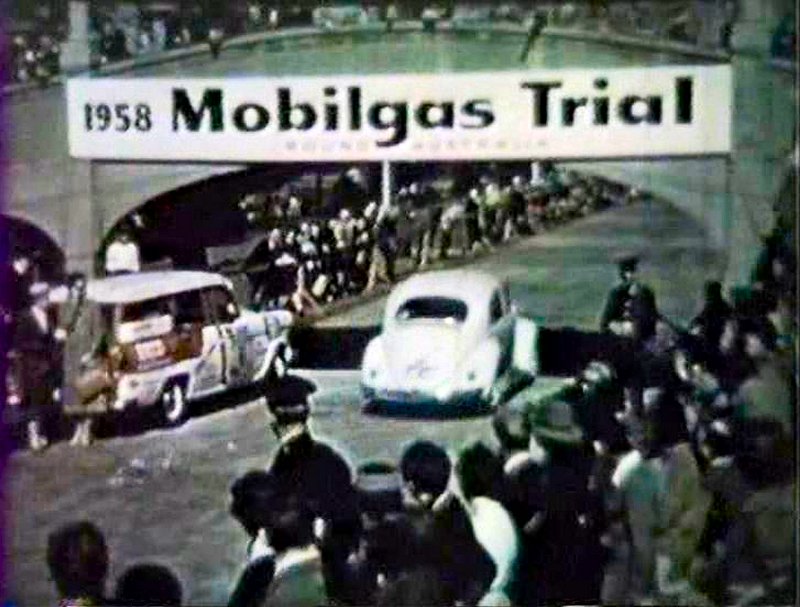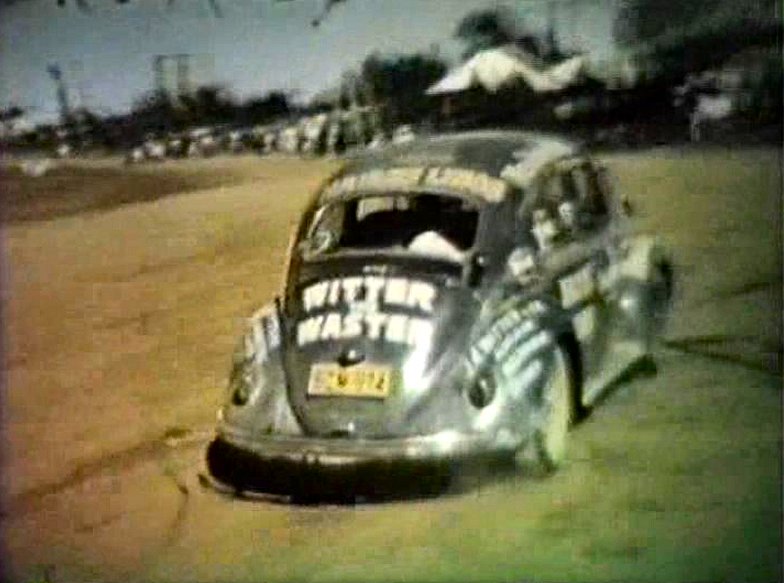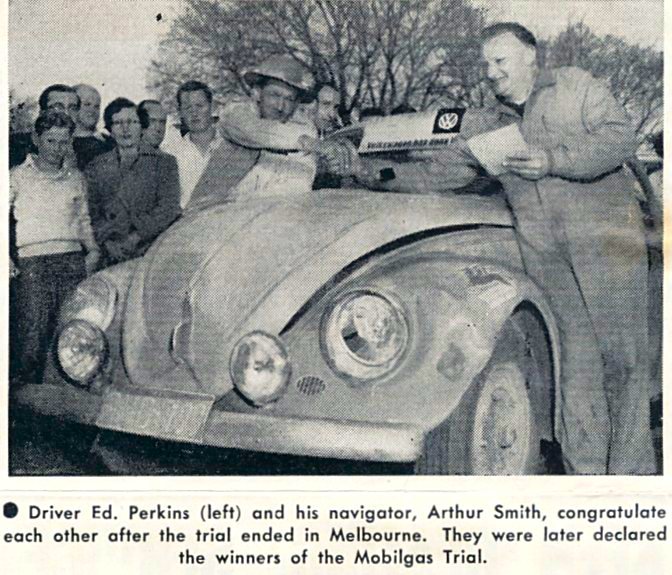The Round Australias
Originally part of my 1993 book ‘Knowing Australian Volkswagens’, greatly expanded and rewritten
It has often been said that Volkswagen’s successes in the early ‘Round Australia’ trials really launched the VW brand in Australia. Their regular wins established the VW reputation for toughness, reliability and the ability to handle Australian conditions. Never before had a small car been able to match (let alone beat) the large Australian, American and British cars of the time in rough, outback conditions.
Volkswagen’s successes have become legendary, with the specifics lost in the mists of folklore. We’ve seen writers state that Volkswagens ‘won countless Redex trials.’ No they didn’t! They won just one of three. VWs also won just one Ampol trial of three, with two close seconds. It was the Mobilgas trials that VW dominated – they won all three of three, including a 1-2-3-4-5-6 result in 1957.
This is the short story of the Australian reliability trials of the 1950s, and how the Volkswagens performed. You can read some more detailed histories in various issues of our club magazine ‘Zeitschrift’, and links will be provided as we go.
Back in the early 1950s it was unthinkable that anyone could possibly drive a standard car around Australia, the 7.6-million square-km island continent nation. Australia is only slightly smaller than the continental United States, but with a population of just 9 million people then (and only 25 million today). Nearly half of the land area is arid desert or semi-desert, confining what population there was to a narrow band down the south-eastern coast. A trip from Sydney to Melbourne or Brisbane took two or three days, and a week or more to Adelaide and Perth. Most main highways were unsealed, there were no motels and there were gaps of many hundreds of km between petrol stations. Out there was the great unknown.
The English boss of the Redex oil and petrol additive company, Reg Shepheard, arrived in Australia in 1949. He saw how vast and undeveloped the ‘outback’ of Australia was, and how primitive were the Australian ‘highways’. He decided that a car reliability trial was the ideal way to promote his Redex products.
1953 Redex Trial
The first Redex endurance and reliability trial was held in 1953. It was sponsored by Redex and organised by the Australian Sporting Car Club. It was billed as the world’s longest trial, some 6,500 miles (10,460 km) long. The route was published in advance – Sydney to Brisbane via Tamworth; Rockhampton, Townsville; then inland to Mt Isa and north to Darwin; south to Alice Springs and Adelaide; to Melbourne, then home via Albury to Sydney.
It was not a ‘race’, it was a reliability trial, where teams were assigned a certain period of time to cover the distance between checkpoints. Points would be lost for each minute early or late arrival at a control; 100 points off for not following instructions, and 500 points off for replacing components on the cars. Cars had to be standard, apart from some safety and protection devices, extra fuel tanks, tools and spares, and supplies such as food and water.
The event attracted famous drivers and navigators from all over Australia, including Jack Brabham, Lex Davison, David Mackay, Stan Jones, Doug Whiteford, Jack Murray and radio star Jack Davey. Excitement was intense; nothing like it had ever been seen before and it was all over the radio and newspapers for weeks before the start.
No Volkswagens took part in the 1953 Trial, as they had not yet gone on sale in Australia (and would not until March 1954). There were 192 starters of a great variety of other makes. Most of them were large cars, including Holdens, Ford Customlines, Consuls, Zephyrs and V8 sedans; Chevrolets, Mercurys, Chrysler Plymouths, Hudsons, Standard Vanguards, Humber Super Snipes and Jaguar Mark 7s. Some teams chose smaller, fast cars such as MG-TDs, Rileys, Fiat 1900s or Ford Anglias, while a few chose family cars such as Austin A40s and Morris Minors. The only ‘near’ VW was a single Porsche 356, entered by Hamiltons of Melbourne.
50,000 people watched the start on Driver Ave outside the SCG on Sunday 30 August 1953, where cars were flagged away, one by one, at 3-minute intervals. The first car left at 2pm, and the last car didn’t leave until 11:30pm, by which time the first cars were already well past Tamworth. 150,000 people lined the Pacific Highway out of Sydney.
By Townsville just 10 cars had dropped out, and 128 of the remaining 177 cars had perfect scores. The next section to Mt Isa was the first of the famous ‘horror stretches,’ a 980 km bush track that had to be driven in 16 hours. The smooth 1,760 km bitumen US army highway to Darwin gave the drivers a break, when 132 cars remained and 42 were still without any points lost.
The field headed south again on the bitumen to Alice Springs, then the dirt and gravel highway to Coober Pedy and Adelaide. More cars dropped out, but at Adelaide there were still 11 cars with clean sheets. There was only tarmac highway remaining on the run home to Melbourne and Sydney, which caused concern. Organisers feared that it would be impossible to announce a winner if more than one car finished without loss of points.
So they threw in a secret ‘elimination’ section near Goulburn, which set an unfortunate precedent for last-minute changes that were to cause controversy and arguments in later trials. The cars floundered through an 18 km mud bog and a flooded river crossing a metre deep. Everyone lost points.
138 cars made it to the finish in Sydney, far more than everyone expected. It took five hours for the organisers to announce that the winner was Ken Tubman in a Peugeot 203 with only 19 points lost, just ahead of Ken Robinson in a Humber Super Snipe with 20 points lost. Only 15 seconds in the mud bog section separated the two cars.
The Porsche 356 did finish, but near Mt Isa it had hit a kangaroo and badly damaged the front suspension. With 808 points lost, it finished way down the list.
The event was a rousing success, and the shortcomings of the cars and roads of the time were clearly shown. The win caused a sales rush on Peugeots; every new model in the country was sold within the week.
But the professional drivers later agreed that the trial was too easy (apart from the elimination section), with too many rest stops and required averages set too low. All agreed that the next Redex trial should be bigger and tougher.
Read more about the 1953 Redex Trial in the July 2008 issue of Zeitschrift.
1954 Redex Trial
The 1954 Redex Trial was indeed bigger and better, circumnavigating the continent for the first time and increasing the distance to 9,600 miles (15,450 km). Only 18 days were allowed, four more than previously, which tightened things up considerably. Only post-war cars were now allowed to compete, outlawing some pre-war clunkers from the previous trial. The number of modifications allowed was also tightened, and crucial parts were marked with fluorescent paint to ensure they were not replaced. Cars still had to maintain set averages for the sections, and could not exceed any posted speed limits.
The organisers gave themselves the option of inserting more ‘elimination’ sections if required, as well as adding or moving secret controls to catch cheaters. The starting order of the cars would be rotated, meaning that the ‘leading’ cars on the road were not necessarily those leading on points.
The 1954 Redex Trial was promoted as the biggest, toughest, longest, richest and most dramatic motor trial in history, and interest was intense. 246 cars were entered, in an even greater colourful collection of makes and models as before. The most popular choices were again big cars such as the Holden, Standard Vanguard, Humber Super Snipe, Plymouth, DeSoto, Ford Customline and Zephyr, and naturally a few more Peugeots.
For the first time, there were some examples of the funny-looking German Volkswagens that had just gone on sale in Australia a few months earlier. Four were entered. NSW VW distributor Lanock Motors entered one VW, driven by eastern suburbs VW agent Jack Jeffrey, while Melbourne VW dealer Regent Motors entered another, driven by Melbourne Herald journalist Laurie Whitehead. There were also two privateers entering VWs, Keith Carmody from NSW, and Ralph Wilson from Victoria.
All entrants had to attend a road safety lecture by the Road Safety Council, and the NSW Police Traffic Branch. The cars were carefully scrutinised before the start the next morning, from the dirt speedway ring inside the parade ground of the old Sydney Showground. Another huge crowd saw the cars flagged off from midday on Saturday 3 July 1954, this time at two-minute intervals.
All cars made it safely to Brisbane, but a few secret speed traps meant only 203 cars were clean-sheeted. Slower average speeds on the run north made for boring driving, and 50 more cars were pinged by the Police between Brisbane and Rockhampton. Another 23 cars were booked by the time the field reached Townsville, and just 129 cars had clean sheets.
The dirt road to Mt Isa was actually in worse condition than before, and was little more than a bush track. A secret control near Cloncurry was to decide the Trial results, as car after car was pulled over for speeding. Only two cars from the 207 remaining at Darwin now had clean sheets.
Into Western Australia the cars had to contend with mining trucks, huge sand drifts, choking dust and hundreds of cattle grids as they made their way through Broome and Meekatharra. Many cars hit rocks or crashed out, and only 146 cars were still in the Trial by the time they reached Perth. Only one car still had a clean sheet – the 1948 Ford V8 known as the ‘Grey Ghost’, driven by celebrity race driver and prankster ‘Gelignite’ Jack Murray and his co-driver, Bill ‘no relation’ Murray.
The run to Port Augusta was almost 2,000 km of corrugated gravel ‘highway’ that shook the cars to pieces, and more police speed traps were set up before Adelaide. Scrutineers suddenly descended on the cars in Adelaide, penalising numerous teams for replacing parts. Gelignite Jack cruised in throwing balloons at the crowd, and he still had a clean sheet.
From Melbourne the route was kept secret until the last minute, with a foggy, snowy 40 km/h run set across the Snowy Mountains. After a snow fight for the cameras, the Murrays averaged 89 km/h into Talbingo despite running out of brakes halfway down the mountain.
Crowds mobbed the leaders in Canberra and in Wollongong, with Gelignite Jack busy signing autographs after their arrival. It was a fast run back to Sydney in the evening, where 20,000 people awaited the finish at the Sydney Showground. Driving in wearing his famous gorilla mask was the winner, 'Gelignite' Jack Murray in his 1948 Grey Ghost Ford V8. Amazingly, Gelignite Jack still had a clean sheet, no points lost at all over 18 days and 15,400 km. The Murrays were extraordinarily popular winners, and were mobbed by the adoring crowd.
In second place was Bill Patterson in a Peugeot 203, 8 points down, followed by ‘Duck’ Anderson in a Holden, 14 points lost, and then a Vanguard, Humber and a Ford Customline. Only 120 cars finished the 1954 Redex trial.
And what of the Volkswagens in 1954? Laurie Whitehead's Regent Motors Volkswagen #154 was the best of the four, finishing in equal 13th position (and 2nd in 1100-1500cc class) with 29 points lost. Apart from the usual dust and slightly bent bodywork, the VW suffered no major problems. Ralph Wilson's privateer VW #70 also finished the trial, back in 95th spot with 236 points lost. He slid into a ditch near Yass and had also spent considerable time repairing their damaged front suspension back in WA, and would have finished higher otherwise.
Keith Carmody’s VW #192 retired in Cloncurry after hitting a kangaroo, and Jack Jeffery’s Lanock Motors VW #151 retired at Kalgoorlie after losing a rear brake drum – the split pin had not been replaced after repairs in Perth. But considering they were new to Australia, and had been given no chance at all to start with, it was a promising start for the Volkswagens.
Read more about the 1954 Redex Trial in the August 2008 issue of Zeitschrift.
1955 Redex Trial
The 1955 Redex Trial was lengthened further, to 10,500 miles (16,900km) over 22 days, including Cairns for the first time; the coastal route to Perth via Carnarvon, and more inland roads than before such as a detour to Broken Hill, plus several new horror sections. The 3,000 km Monte Carlo Rally was considered an ‘endurance’ event, but the 1955 Redex Trial was five and a half times longer! The Redex Trial was listed on the FIA calendar for the first time.
Competitors would be required to clock on and off from control points, using an IBM bundy clock flown to the locations ahead of the cars. Long-wave radio and Morse code telegraph communication would be established from the control points to the Sydney head office.
Mechanical rules were tightened further, with hardly any modifications allowed. Welding could not be done, and repairs were limited to straightening, tightening and adjustment. It was forbidden for teams to work on cars during their rest breaks. Any mechanical repairs had to be done on ‘running time’, either after checking out of a control or before arriving at the next. Various major parts could not be replaced, and these were marked with radioactive tracer paint.
There were 176 starters, in the same wide variety of cars as before but with a noticeable trend away from large American cars. There were more Holdens, Vanguards, Peugeots, Humbers and Zephyrs than before, although ‘Gelignite’ Jack Murray was back in the same 1948 Ford V8 and there were still some big Customlines and Plymouths. There were more small cars too, including Morris Minors, Austins, Fiats and MGs.
After just four VWs competing in 1954, this time there were no less than 16 VWs entered, the third-most popular car after the Holden and Vanguard. Experienced drivers such as Laurie Whitehead, Frank Kleinig, Theo Borrer, Greg Cusack and Eddie Perkins were in VWs, as well as the oldest driver in the trial, Mrs Charlotte Hayes (66). Even so, in the lead-up to the start the VWs received no press, with reporters only interested in Gelignite Jack.
This time the start was moved out to Parramatta Park, where the 176 cars were flagged away from noon on a festive sunny but windy Sunday 21 August 1955. They drove through the night via Tamworth to the first rest at Southport, where 143 cars were clean-sheeted. The VW #79 of Swedish drivers Ollie Torling and Sten Jacobsen was already out, after sliding off the road and overturning near Casino. VW #172 of Don Gorringe had a smashed windscreen, but he and the other 14 VWs all arrived without loss of points.
It was a fast run via Toowoomba to Rockhampton, and dozens of cars were booked for speeding. The Rockhampton to Townsville run contained the infamous Sarina horror section, with a track that resembled a ploughed field; rocks and tree roots, muddy creek crossings and thick swirling dust that reduced visibility to only a few metres. Wrecked cars were strewn over the section. By the time the field limped into Cairns, just 130 cars were left in the trial. Then the organisers threw a surprise inspection of all the cars, penalising almost every one for damaged suspension and exhausts. Everyone had now lost points.
A Vanguard was leading the trial, but Laurie Whitehead’s VW was second and Eddie Perkins’ VW was third in front of a Holden and Peugeot. There were 12 more VWs still in the trial, with the best of these in 15th, 16th, 29th and 31st.
The run from Cairns to Hughenden and Mt Isa contained the same horror stretches of previous Redex trials. The 1,320 km was the toughest yet. VW #166 of Don Elliott overturned and retired, while VW #131 of Cyril Lyons got stuck in the scrub. There were now 10 VWs left. The leading Vanguard of Eric Nelson hit a kangaroo and was forced to retire, so taking the lead at Mt Isa was the VW #90 of Laurie Whitehead (16 points), followed by Carl Kennedy’s Peugeot, then the VW #2 of Eddie Perkins in third (27 points).
It was a long, hot run west to Tennant Creek and north to Darwin, but cars could at least cruise quickly on the bitumen. At Darwin the cars were inspected again, but no penalties were handed out. Jack Murray was still getting the headlines and radio interviews, but Laurie Whitehead’s VW was still leading and Eddie Perkins’ VW was still third. There were just 97 cars left, including nine VWs after Theo Borrer’s VW #120 had retired. Still going was 'Grandma' Hayes in her VW #58.
The run south and west to Fitzroy Crossing was not as tough as the QLD sections, but longer, dustier and more tiresome. Frank Kleinig wrecked his VW #110 after hitting a rock culvert, leaving eight VWs in the trial. The second-placed Peugeot of Carl Kennedy took the wrong road and lost an hour, meaning that the Eddie Perkins VW was now second behind the Laurie Whitehead VW.
More drivers lost their way on the vast, featureless clay plan country from Broome to Port Hedland. VW #171 of Alan Cook cracked his sump on a rock, stranding the VW many miles from civilisation. It was three days until they were towed out. Harry Weal’s VW #132 was also too damaged to continue, so at Port Hedland there were just 6 VWs left and 76 cars altogether in the trial. VWs were still 1-2, but the press was still favouring Gelignite Jack Murray (36 points, now in third) to win the trial as they thought his V8 Ford would handle the Nullarbor better than the little VWs.
Mobs of roaming kangaroos caused havoc on the drive south to Carnarvon and Perth, and two more cars dropped out. Positions were unchanged from Port Hedland, but the scrutineers went over the cars one more time. More penalties were given for damaged or replaced parts. For the first time they noticed that the two leading VWs both had small cracks in their floorpans from hitting rocks, but no penalties were given at this time.
The 2,000 km gravel Eyre Highway section across the Nullarbor Plain was the longest and fastest of the whole trial. Jack Murray’s Ford V8 averaged 87 km/h for the entire section, but the leading Volkswagen of Laurie Whitehead averaged 93 km/h. At Adelaide the two VWs were still leading, having not lost any points since Mt Isa. Gelignite Jack was still third but lost another 4 points over the section. All six VWs were going strong.
From Adelaide the cars headed inland to Broken Hill, then south to Mildura, Horsham and Mt Gambier. Torrential rain had turned the dirt roads to bogs, and cars slipped, slid and spun in the mud, some getting bogged to the axles. The two leading VWs arrived at Mt Gambier on time, so close together they seemed like twins. Gelignite Jack’s big Ford struggled in the mud, and he lost 15 more points for late arrival. He dropped back to fifth, overtaken by Malcolm Brookes’ Vanguard and Sam Hecker’s Holden.
It was an uneventful run on the easy tarmac to Melbourne, apart from the biggest crowd of the trial, over 250,000 spectators that lined all the roads into town. In the city the streets were jammed with people, and the police had to clear a path for the cars. Everyone was delayed but no penalties were given out. The Volkswagens were cleaned, serviced and polished by a 14-man mobile workshop from the Spencer Motors VW agency, the first time a ‘factory’ race support team was ever seen in Australia.
After a 16-hour rest period in Melbourne the 65 remaining cars set off for Sydney. The route took them via Lake Eildon to Mansfield, Whitfield and Myrtleford, and crossed into NSW after Corryong. It was a wet and slippery drive, and Laurie Whitehead lost 5 points after taking it slowly and carefully. He was now on 21 points, still leading but just 6 in front of Eddie Perkins. The cars headed to Tumut, Wee Jasper and Yass, after which the trial became a shambles.
Just before Canberra, at Murrumbateman, the cars were directed off the highway and onto a muddy bush track through a paddock. Heavy rains had turned the whole area into a sea of mud, and most of the field became bogged to the axles. Some cars were stuck all day before teams of horses could finally pull them out. The air was blue with swearing as frustrated and angry teams tried to dig themselves out.
The already-retired VW driver Greg Cusack lived in Canberra and he knew the area well. He and his father Greg Snr were able to guide the remaining VWs along the correct path through the bog with their Land Rover, and later stayed on to help many other cars get through. Only eight cars made it to Canberra in time, while the rest were hopelessly bogged. It was a monumental stuff-up – which the organisers rectified by simply cancelling the section.
The stragglers headed home via Goulburn, the Macquarie Pass, Wollongong and Heathcote. The crowds were waiting at midday at Parramatta Park but the first cars didn’t arrive for several hours after their due time. Tired crews posed for photographs but working out the results would take some time. There was also the question of possible penalties after the inspections at Cairns, Darwin and Perth.
The six VWs had made it to the end, and 63 cars arrived by the midnight close-off. All cars were inspected again. Gelignite Jack was sensationally disqualified for not putting his car in for inspection, in protest at the organising stuff-up. It made front page news. Redex penalised both the leading VWs 500 points for the floor cracks, as well as numerous other leading vehicles for having similar damage.
Four days after the trial ended, Redex announced that the winner was Carl Kennedy’s Peugeot, followed by George Kook’s Vanguard and David McLachlan’s Ford Customline. Laurie Whitehead’s VW was fourth, and Eddie Perkins' VW fifth. There were immediate protests from eight teams, and the VW teams lodged appeals to the Confederation of Australian Motor Sport (CAMS) in Melbourne. Coming on top of the arbitrary inspections, reversing decisions and the Canberra mud bog stuff-up, it was a shambles.
George Shepheard of Redex refused to accept CAMS’ authority to hear appeals, insisting their results were final. Some teams threatened to appeal to the world body (the FIA) in Europe if their CAMS appeals were unsuccessful. Redex threatened to involve the RAC, the British arm of the FIA. Laurie Whitehead was filmed for a newsreel, describing the penalty situation as ‘unjust’, and he said that all the organisers could do was deny him his prize money.
A month after the trial ended, CAMS’ Court of Appeal announced the final results of the Redex Trial. The last set of scrutineering penalties incurred by the teams were removed, as were any penalty points for the mud bog. CAMS also decided that the VW floor cracks were not ‘structural’, only ‘superficial’ and hence should not be penalised. The VWs’ 500 point penalties were removed.
CAMS therefore announced that the winner of the trial was Laurie Whitehead’s VW #90 (21 points), followed by Eddie Perkins’ VW #2 (27 points). Third was Malcolm Brookes’ Vanguard, fourth was Bill Hayes’ Ford Customline, and fifth was Carl Kennedy’s Peugeot. The other four Volkswagens finished in 15th, 30th, 31st and 32nd places. Since the VWs had lead from Mt Isa to the finish, this seemed the correct result.
Redex still refused to accept these results and withheld the prize money while they appealed to the RAC in London for clarification. It took another two months for the RAC to confirm that its authority was fully delegated to CAMS, and that the CAMS decisions were indeed final.
Read much more about the 1955 Redex Trial in a five-part series, published in the September, October, November, December 2008 and January 2009 issues of Zeitschrift.
You can also watch a 2-hour documentary on the three Redex Trials, complete with excellent period film, and commentary by former Australian cricketer and TV personality Mike Whitney, here.
1956 Ampol Trial
There were no more Redex Trials after 1955. Redex had decided to withdraw from motor trials, as they no longer wished to be involved. People were associating the name ‘Redex’ more with the round-Australia trials rather than the oil additive they were trying to sell. Redex was also unhappy about their results being overturned by CAMS.
Instead, the Australian Sporting Car Club in Sydney quickly found new sponsorship for a 1956 Trial from Ampol Petroleum, and two weeks in August were set aside for an Ampol Trial. However, at the same time, CAMS in Melbourne announced they had secured Mobilgas Petroleum as the sole sponsor of a 1956 Trial, and no other event would be allowed. The NSW-based ASCC and its affiliate clubs found this unacceptable, and broke away from CAMS to form the Council of Combined Motor Clubs (CCMC) in opposition to CAMS. The CCMC would run the Ampol Trial in opposition to the CAMS’ backed Mobilgas Trial.
Neither oil company nor control body would back down, so both trials went ahead in 1956, the Ampol Trial in July and the Mobilgas Trial in August. CAMS claimed the Ampol Trial was illegal, and threatened to disbar any Ampol drivers and cancel their competition licences. Still, many of the famous Redex drivers chose to compete, including the media favourite ‘Gelignite’ Jack Murray, although Laurie Whitehead and Eddie Perkins did not.
The Ampol Trial of 6,500 miles (10,460 km) had 113 starters, including ten Volkswagens, and departed from the esplanade at Bondi Beach on Sunday 15 July 1956. It was a shorter trial than the 1955 Redex, avoiding WA entirely and going clockwise rather than anti-clockwise from Sydney. The cars drove via Goulburn and Canberra to Melbourne, then Mildura and Adelaide and north to Alice Springs and Tennant Creek before turning east for Mt Isa, Hughenden and Cairns, then down the coast to Brisbane and the finish in Sydney.
The trial was marred by rain and mud, almost resulting in some sections being cancelled, but the cars struggled along the unsealed outback highways. High average speeds were set for the sections, while police clamped down hard on speedsters. By Melbourne the first VW, #87 of Hogarty and MacRobertson had already withdrawn, while VW #109 of Jack Letchford rolled over but was able to be righted.
Rains continued through Victoria, and after Mildura a detour around flooded roads at Renmark was necessary. By Adelaide most cars were still going but only nine cars had less than 20 points against them. The dirt highway north to Coober Pedy was a sea of mud, and by Alice Springs the field was down to just 61 cars. The leader was a Peugeot (163 points), while Jack Witter’s VW #78 was second (236 points), Max Goldsmith’s VW #17 was third (251 points), and other VWs were 7th, 10th and 11th. The VWs were looking good, but the press barely mentioned them. The interest was always on Gelignite Jack, who even had his own column in the Sun-Herald.
More rough and muddy roads to Mt Isa and Hughenden caused more havoc, and by Cairns just 37 cars were left in the trial. The leading Peugeot had now lost 220 points, while Max Goldsmith’s VW was now in second with 254 points. Jim Letchford’s VW was sixth (648 points), Syd Tosh’s VW was seventh (649 points) and other surviving VWs were 13th, 18th and 26th.
Apart from a few mud and direct sections, it was a very fast run down the bitumen to Brisbane, with tired drivers having to maintain high speeds. Tragedy struck the Trial just past Grafton, when the MG-TF of Les Slaughter and Bill Mayes failed to take a bend, plunged down an embankment and overturned into a creek. They were both killed, the first fatalities in the around-Australia trials.
The news brought sadness to the finish at Bondi Beach, when the leading Peugeot 403 of Wilf Murrell and Alan Taylor managed to hold their lead and claim first place (258 points). Max Goldsmith’s VW #17 was second (395 points), and Jack Letchford's VW #109 was fourth behind a Holden.
VWs also finished 9th, 22th, 28th and 30th. Volkswagen was awarded the Teams Prize. The people’s favourite, Gelignite Jack Murray and his Ford V8, finished in 17th place with 1,310 points lost.
1956 Mobilgas Trial
CAMS banned the Ampol drivers from the Mobilgas Trial of 8500 miles (13,680 km), and suspended nearly thirty drivers and officials from ‘official’ motorsport for up to five years. This included celebrity and pro drivers Jack Murray, Peter Antill, ‘Duck’ Anderson and Ray Christie. Much publicity was made of the Mobilgas being an ‘official’ trial, and CAMS being the only ‘official’ organiser of motor sport in Australia. Apart from a cash prize of £3,000 (almost $100,000 today) and a £250 trophy, CAMS and Mobilgas also offered the winner a trip to Europe and entry in the Monte Carlo Rally (!) All competitors who finished the entire course within 24 hours of the scheduled finish would receive £30.
Yet the Mobilgas did not have the same popularity with the public, perhaps due to Aussies favouring the ‘underdog’ Ampol trial. Only 83 cars entered the Mobilgas, considerably less than the Ampol. 22 were Volkswagens, the largest group in the trial. The start on Saturday 5 August was at Parramatta Park, same as the ’55 Redex, but this time the spectators were charged 1/- each to watch the start, plus 2/- for cars and sixpence for children. This further damaged the public perception of the Mobilgas, and the crowd was just 6,000 people.
The Mobilgas followed the proven anti-clockwise Redex route to Brisbane and Rockhampton via Armidale, then cut inland to Mt Isa and straight across to Tennant Creek and Fitzroy Crossing without going to Darwin. From Port Hedland the route took the inland route to Perth via Meekatharra, then across the Nullarbor to Adelaide and home via Melbourne.
Very fast average times were set on the tarmac sections, and drivers found themselves having to drive at over 130 km/h to maintain the required average and the police had a field day. By Emerald in Queensland only 11 of the 79 remaining cars had clean sheets. The field then had to tackle the famous horror section to Mt Isa. None of the cars arrived in the time set, and many were hours late. Everyone lost points, and the field was down to 63 cars, of which six were still unaccounted for.
The ladder-board could now be tabulated, and the leader was the #16 VW of brothers Eddie and Lance Perkins (48 points). An FC Holden was in second place (62 points), but close behind them was the #14 VW of Bob Foreman, the #89 VW of Greg Cusack, the #85 VW of Alan Griffiths and the #49 VW of John Vaughn.
The rough roads and very difficult fast driving continued to cull the entrants, with 53 still going at Tennant Creek. But by the time the field struggled into Fitzroy Crossing there were just 38 left. Harry Smith’s VW #41 retired, and so did the women’s team #24 VW driven by Norma Harrison after the girls smashed their windscreen, then blew their engine. Another VW, #24 of Tom Archer was unaccounted for somewhere between Mt Isa and Camooweal.
Leaders Eddie and Lance Perkins cruised their VW into Port Hedland two hours early, and had plenty time for minor adjustments before checking in. They had covered the west QLD, NT and WA Kimberley sections without losing any more points. The Holden was still second, but followed by four more VWs. John Vaughn failed to check in in time and his VW dropped out of the top ten. The organisers considered the much reduced field and decided to remove all ‘horror’ sections between Melbourne and Sydney.
Several more cars dropped out after hitting kangaroos, and 32 cars left Port Hedland after a surprise brake and light inspection; all passed. The Police were out in force in Perth to ensure all drivers observed the 30 mph (48 km/h) speed limit. After the rest period many drivers drove straight to garages for repair after clocking out. At Kalgoorlie the biggest crowd of the trial saw the cars pass through and begin the longest leg, the 2,000 km across the Nullarbor Plain to Ceduna.
The top 10 cars all arrived in Ceduna without further loss of points after a fast run across the country on the corrugated gravel Eyre Highway. Eddie Perkins’ VW was still leading, followed by the Holden and two VWs, a Customline, two more VWs, a Vanguard and another VW. The hardest part was over, and it was a relatively civilised route back to Sydney. Only some re-routing in Victoria was considered to avoid flooded roads. There were still 32 cars left at Adelaide, with no more retirements since Port Hedland, but Alan Griffiths’ VW lost one point for being one minute late into the control.
Cars began arriving in Melbourne at 4am Saturday for an 11-hour rest, then left for Sydney at 3pm via Albury, Goulburn, Bomaderry and Wollongong. The drivers were allowed a two- hour stop in Wollongong for breakfast, tidy-up and shave, and a leisurely Sunday drive to the finish. They reached Sutherland at 12:30pm, then drove over Tom Ugly’s Bridge and the Princes Hwy to St Peters, then Ricketty St and Gardeners Rd to the Kingsford junction and Anzac Parade to Moore Park and Bondi.
A crowd of around 15,000 was there to see the cars cross the finish line at Bondi Beach, although the organisers were hoping for 40,000. The winners, after the leading the trial all the way from Mt Isa and not losing any points since, was the VW #16 of Eddie and Lance Perkins (48 points lost). The FC Holden of Jack Masling was second (62 points), and the #14 VW of Bob Foreman in third. VWs also finished 4th, 6th, 9th, 10th, 11th, 14th, 15th, 16th, 17th and 26th. Again, not surprisingly, VW won the Teams Prize, as well as the state prizes for every state and territory (except for NSW), and the overseas prize (VW of Miss Alice Braddock, New Zealand).
Eddie Perkins won £5,750 prize money and the chance to compete in the Monte Carlo rally in Europe (which he did the following year, but his Porsche 356 retired).
1957 Ampol Trial
The political split continued into 1957, with CAMS still trying to ban and/or prosecute the rebel 1956 Ampol drivers and officials, and the 1957 Ampol Trial was again denied CAMS approval. But it went ahead anyway, organised again by the breakaway CCMC group with Ampol backing. The CAMS ban on drivers only applied to drivers with a CAMS licence, and these were only a small percentage of potential entrants. The banned CAMS drivers were still free to enter the 1957 Ampol trial, which had a CCMC permit.
Shortly after the 1957 Ampol event was announced, CAMS announced that drivers banned for competing in the 1956 event could have their licences restored in time for the later 1957 Mobilgas trial – on condition that they NOT compete in the 1957 Ampol. Most already banned drivers chose to ignore this, and the Ampol trial attracted over 70 entries.
The Ampol Trial got plenty of newspaper space and radio time, certainly from the ‘underdog’ sympathy but also from news that CAMS was still denying Ampol any chance to gain a permit and still threatening legal action. In spite of the problems it was a happy and well-run event, well received by the press and the public, and it attracted some real professional drivers and teams in spite of its unofficial status.
The ‘unauthorised’ 1957 Ampol Trial started from Sydney on Sunday 7 July, again following a clockwise route through the eastern states and the centre but with some different roads this time. It covered 11,260 km including a stretch along the Birdsville Track through the Simpson Desert.
79 competitors drove away from the start at the crowded promenade at Bondi Beach, straight into snow past Lithgow and down through the Alps to Melbourne where 22 cars still had a clean sheet, four of them Volkswagens. One VW driven by Len Ellick crashed rolled over near Lancefield, just outside Melbourne.
The magnificently twisty Great Ocean Road then sorted out the field, with a high average speed of 76 km/h needed on the 200 km section to Warrnambool, by which time seven cars were still without loss of points. The VW of Lance Perkins and George Reynolds lost 5 points on this section, the only points they lost on the whole trial, when the fuel reserve fitting came off. George had to lie across the tank and blow into it the whole way to force petrol through. 71 cars reached Mt Gambier in heavy fog, and there were still 7 clean sheets remaining. There were no VWs in this group as they had all now accrued some penalties.
After an easy run to Adelaide and Port Augusta, the field headed north-east through the Flinders Ranges. Past the rail-head at Marree and the start of the Birdsville Track, a number of cars ran out of fuel on the long desert stretch to Birdsville. Witter and Stewart’s VW ran out of petrol, but Perkins and Reynolds were close behind in their VW. They stopped and siphoned out eight litres for them. Both VWs then raced together to Birdsville in top gear, with Witter and Stewart losing only 3 points for their slight delay.
The field had to cross the wide flooded Diamantina River just before Birdsville, with the water at least 60 cm deep. Only 24 of the cars checked into Birdsville on time, with 45 others halted or delayed by hours somewhere back along the sand, mud and gibber Birdsville Track. Many drivers arrived in Birdsville barefoot and with mud up their legs. The #77 Holden was now the only car with zero points, but was closely followed by the #26 VW of Jack Witter (3 points), a Peugeot (4 points) and VW #27 of Lance Perkins (5 points).
The leading cars drove from Birdsville to Mt Isa without incident but a few minor penalties. The Holden dropped 2 points; Jack Witter another 1 point. All teams had now lost some points and the Holden was still leading, but VWs were close behind in 2nd, 4th, 8th and 10th. On the run to Cairns Jack Witter’s VW hit a bull and four kangaroos, and just made the Cairns control with 45 seconds to spare. John Garard’s leading Holden was delayed two hours by an upholstery fire, but he made up the time and arrived in Cairns on time after a very fast drive. The leader board was the same as Mt Isa, and the organisers actually refunded some penalty points as they discovered the time clock back in Warrnambool was wrong.
On the run south of Cairns the leading Holden copped a battering, cracking its front cross-member and the rear window fell out near Mackay. Next was the infamous 160 km Sarina-Marlborough horror stretch. The Holden lost 19 points on the section, dropping back to third place. Both VWs of Jack 'The Waster' Witter and Lance Perkins got through on time and without loss of any points, and took the lead in the trial. The route then switched back inland again to Emerald and Roma before the last major stop at Brisbane, a long but mostly uneventful detour.
The run down the coast to the finish in Sydney was also mostly without incident, except for a slight detour by the leading VWs near Coonabarabran thanks to a signpost that had been turned around the wrong way. The field headed home via Narrabri, Dubbo and Newcastle. Lance Perkins and George Reynolds’ VW got to Chatswood, almost to the finish, when their green light suddenly came on. All the oil had leaked out from a loose oil cooler and the engine was dry. They drove the remaining 20 km carefully to the finish at Bondi Beach without any problems.
The route to the finish from Chatswood was the Pacific Hwy south over the Harbour Bridge, then Grosvenor, Bridge and Macquarie Sts to St Mary’s Cathedral (the Cahill Expressway didn’t open until 1958), then up William St and New South Head Rd to Rose Bay. Right at O’Sullivan St at the golf course, then down Curlewis St (and past Gelignite Jack’s Bondi Garage on the left) to Bondi Beach.
40,000 people lined the Pacific Hwy to see the 42 surviving cars reach the finish. Another 20,000 were at Bondi Beach, and they broke the barricades when the last car, radio star Jack Davey’s Chrysler, crossed the finish line.
The Jack Witter/Doug Stewart VW #26 was the winner, with only 3 points lost over the whole trial. They won £4,000 and a large trophy, plus trade sponsor prizes of a TV set, washing machine and several other items. The Lance Perkins/George Reynolds VW #27 was second with only 5 points lost, and they collected £1,500 and two weeks’ holiday in Surfers Paradise. The Sheedy/Roberts VW #19 finished 7th, the Dean/Houstein VW #64 was 8th and the W.J. Robinson VW #49 was 11th, but this time Volkswagen was pipped by Holden for the Teams Prize.
But again the VWs didn’t get much publicity in the papers. With no Gelignite Jack in the trial, the press instead featured 71-year old Blanche ‘Granny’ Brown and her son Vince in her 2-tonne 1927 Rolls Royce, which finished an amazing 5th overall.
1957 Mobilgas Trial
After the excitement of the 1957 Ampol Trial, the Mobilgas was something of an anti-climax by comparison. The public was getting bored with two competing ‘biggest, longest, richest’ endurance events and the still feuding petrol companies and controlling bodies.
All the top Australian drivers (who were not banned by CAMS) were competing, but the event was only enlivened by some new overseas entries that added a bit of colour and variety to a somewhat tired formula. Teams from Germany entered three cars, New Zealand two, and the USA, Czechoslovakia, Japan and New Caledonia one each. The Japanese Toyota ‘Toyopet’ entry was the most popular curiosity with the press, being driven by Kunio Kaminomura and Kojiro Kondo (and navigated by Australian Lindsay Hedley). Altogether 102 entries (including 23 Volkswagens) were received but only 86 cars made it to the start, which for the first time was in Melbourne.
To try to inject some interest in the formula, the organisers did not publicise the route in advance. Instead, it would be kept secret and instructions (only as far as Adelaide) handed out only minutes before the start. Further instructions would be handed out at Adelaide, then Perth, Derby, Darwin, Rockhampton, Brisbane, and Sydney.
Melbourne Lord Mayor Sir Frank Selleck waved the cars away from Royal Park, just north of the Melbourne CBD, on Thursday 22 August. It was the first time a round-Australia trial had started on a weekday rather than a weekend so a small crowd of just 9,000 cheering spectators watched the start. But thousands more lined the streets out of town towards Geelong.
The Americans crashed their big Ford Customline only 500 km into the trial, failing to take a sharp curve at over 100 km/h. The VW #7 of Evan Thomas also crashed out when it overturned in heavy fog near Hamilton. By Adelaide 12 of the 79 cars had a clean sheet, including four VWs and two Porsche 356s. By Ceduna the clean sheeters were down to seven, including two VWs and the two Porsches.
The field headed for a fast run across the Nullarbor on the gravel highway. Two of the smaller British cars broke their crankshafts, while the Japanese Toyopet broke a valve. The Japanese car was mentioned in every news bulletin. By Albany at the far south west of WA, the same seven cars were still clean-sheeted, but the police clamped down on speeders on the run into Perth. 75 cars were still going but only two cars were now on zero points, the VW #50 of Bob Foreman and a Vanguard driven by famous race driver Harry Firth. Behind them on only 1 point lost was Laurie Whitehead’s VW #76, then four cars on 2 points, and three cars on 3 points. The Japanese Toyopet was on 679 points and second-last.
In Carnarvon the Peugeot driver Doug Whiteford was penalised 500 points for washing his car at the control point; the rules were that no ‘work’ could be done on them during rest periods. This penalty was later removed. The press reported the Toyopet had hit a kangaroo, denting the guard and smashing the lights, but barely mentioned that Volkswagens were currently first and third. The all-woman VW team of Norma Harrison and Audrey Millgate blew up their engine and had to be towed into Broome.
The VW team improved further when organisers agreed to remove a 10-point penalty on VW driver Greg Cusack. He had been penalised for late arrival at the Perth control after helping a stranded competitor, and this was removed on appeal. He was now on just 1 point and on equal second with the other VW of Laurie Whitehead. The Toyopet must have dropped out by this stage as it was not mentioned again. 68 cars left Derby, but only 59 made it through the Kimberley to Darwin. Drivers described the section as the worst ever, but at Darwin the leading cars had not changed – VW/Vanguard, then VW, VW, Holden, VW, Jaguar, VW.
The route south east was an unusual one, across the Barkley Tableland through Anthony Lagoon, Brunette Downs and Alexandria Downs before rejoining the Barkley Highway to the QLD border and into Mt Isa. The next 140 km stretch to Cloncurry was a ‘horror’ section with mobs of kangaroos, creek crossings, boulders, hair-pin bends and a maze of unmarked size roads. A time of 2 hours 26 min was set, which proved almost impossible to achieve.
The field staggered into Cloncurry with bumpers and lights ripped off and loose mudguards flapping. The joint leader Harry Firth crashed out 15 km from Cloncurry when his Vanguard burst a rear tyre and overturned. They had to be towed into town, which left Laurie Whitehead’s VW solely in the lead. However he too lost points on the tough Alpha to Emerald stage, and by Rockhampton the entire field had dropped points from Darwin. It was becoming a Volkswagen parade. Laurie Whitehead’s leading VW was on 6 points, followed by the Bob Foreman VW (11 points), John Hall’s VW (15 points), Jack Vaughan’s VW (17 points). Further back was Eddie Perkins’ VW (27 points), Tony Archer’s VW (76 points), and Greg Cusack’s VW (80 points), equal with a Vanguard. VWs were running 1-2-3-4-5-6-eq7.
After the run from Rockhampton to Toowoomba, the cars arrived for their last rest period at the Brisbane Exhibition Grounds, then headed to Sydney via Lismore, Tenterfield, Walcha, Wauchope and Newcastle. After a checkpoint at Turramurra, the cars drove across the Harbour Bridge and up Macquarie St, College and Oxford Sts to the Showground where they were impounded overnight. It was a Friday night but only a small crowd turned up to watch the 52 surviving cars arrive. The drivers were tired, and one (Frank Bradshaw) passed out and was taken to St Vincent’s Hospital by ambulance. He recovered and was able to continue next day.
On Saturday morning the cars left the Sydney Showground and headed out along Parramatta Rd to the racing circuit at Mt Druitt for a series of braking, acceleration and reversing tests. The Mt Druitt circuit was built on a former WW2 airstrip and was used from 1948 to 1957. Much of the circuit was built over with housing in the 1960s, but some remnants can still be seen in Whalan Reserve today.
The cars then headed to the finish on Melbourne. Laurie Whitehead told the press his VW was going perfectly and thought he had an excellent chance of winning. He regretted that there was no ‘social life’ on the trial, being purely drive and sleep with no time for relaxation. Other drivers thought some of the schedules caused drivers to take risks; 40 drivers had been booked for speeding in the Tamworth area.
Only small groups of people watched the cars head over the Blue Mountains to Lithgow, Bathurst, Wagga Wagga and Albury. Eddie Perkins checked in too early at the Bathurst checkpoint and his VW was penalised 6 points, but that did not change the leading positions.
A crowd of 35,000 people gathered at Melbourne’s Royal Park to watch the cars cross the finish line. 52 of the 86 starters made it to the finish. As for the leading places - well, Volkswagens finished 1st, 2nd, 3rd, 4th, 5th and 6th overall in a dominating display of toughness and reliability. 18 of the 52 surviving cars were VWs, with only 5 VWs dropping out.
The winner was Laurie Whitehead’s VW #76, with 13 points lost. He became the first driver to win two around-Australia trials, as you remember he had also won the 1955 Redex Trial in a VW. Second was VW #24 of Jack Vaughan with 32 points lost; third was John Hall in VW #18 with 36 points lost. Fourth was the VW of Eddie Perkins; fifth was the VW of Bob Foreman, and sixth was the VW of Greg Cusack. Mrs Geordie Anderson was seventh in a Jaguar.
Volkswagen also won 1st, 2nd and 3rd in the Teams Prize (Lurie Whitehead, Bob Foreman and Eddie Perkins); won the Class B (1100-1500cc) prize and the first six places in that class; plus State Prizes for VIC, WA and ACT. VW even won the ‘New Zealand Special Prize’, thanks to VW-driving Kiwis Alma and Gerald McMillan.
Laurie Whitehead and his navigator Kevin Young were presented with cash prizes and trophies worth £4,760 at a later ceremony at South Melbourne Town Hall. The team also won a two-week holiday in Surfers Paradise.
This was Volkswagen’s greatest-ever domination of a ‘round-Australia’ trial. It was also the only one to start and finish in Melbourne. But crowds were down and newspaper reports were getting shorter. The press and public were quickly losing interest.
1958 Ampol Trial
The problems of the two control bodies and CAMS approval were finally smoothed over in 1958. After several meetings between the boards of the NSW-based CCMC and the Melbourne-based CAMS, a settlement was reached. The president of the CMCC, Mr Dan Macfarlane, said that CAMS had agreed to amend certain rules in their constitution. It was then decided to disband the CCMC, leaving CAMS in sole control of Australian motor sport (which they hold to this day). The bans on Ampol, its trial and its drivers were lifted. Several other oil companies were also showing interest in becoming involved with motor sport. BP and Castrol, for example, already had sponsorship contracts with big name drivers.
CAMS permits were issued for both trials in 1958, which were spaced further apart. The 1958 Mobilgas Trial would be run in August as usual, and would be a Round-Australia ‘smash-em-up’ trial of 10,000 miles (16,000 km) as before.
The 1958 Ampol Trial, however, was a new concept in Australian rallying. It concentrated on the Great Dividing Range of eastern Australia only, which spread over the three eastern states. Difficult back roads took the cars around and across both sides of the range, with some of the roads uncovered forming the basis of the professional rallies of today. There were several hillclimb stages included for the first time. Many of the new sections were already known to local car clubs who had used them for rallies before. The 1958 Ampol Trial was to be a precision test of car and driver, as distinct from the old ‘bash and barge’ endurance contests. The distance was still over 12,000km.
The novelty and challenge of this modern event attracted a tremendous entry of 161 applicants, of which 148 left the start at Bondi Beach on Sunday 18 May via a Mille-Miglia-style ramp. 45,000 people turned up to see the cars off. The organisers stressed that the event was NOT supposed to be a car breaker like a round-Australia, but rather a test of the crews’ ability to maintain a high average speed over relatively good, little-used roads. This attracted quality cars like Jaguar XK120s and some Porsche 1600s, but there were still plenty of Holdens, Vanguards, Zephyrs, Chryslers and Peugeots. No less than 27 Volkswagens were entered.
The route crisscrossed the ranges north to Armidale, Brisbane and Bundaberg, then went west out to Roma, Toowoomba and Stanthorpe. Then south across the western plains of NSW via many loops and devious routes as far west as Coonamble and Griffith and east as far as Tamworth and Lithgow, it crossed into Victoria at Albury. Down to Ballarat, up to Mildura, west to Renmark and the Barossa, then out as far as Port Augusta and Whyalla in South Australia. Back down to Adelaide, Naracoote and Horsham, it twisted back to Mount Gambier and followed the wonderful Great Ocean Road to Melbourne. East to Welshpool and Sale, across the Alps to Cooma, Kiandra, Tumut and Canberra, before the final run through Goulburn and the finish in Sydney.
The first hillclimb came almost immediately at Wyong, where organisers set a very quick six minutes for the tough 7.6 km climb. Only three cars could do it in time, two Vanguards and one of the Porsche 1600s. The higher speeds resulted in a number of accidents, with four cars crashing out in the first 300 km of the trial The VW of Bernard Taylor, Tom Smith and Ian MacDonald overturned just outside Cessnock but they escaped with minor injuries. Another VW driven by Mrs Reginald Goldsmith turned over near Walcha, and sadly Miles Dillon died in Taree hospital after his car crashed down an embankment near Wingham. He suffered a fractured skull.
138 cars reached Brisbane, where all but three cars had already lost points. Only two Vanguard Spacemasters and John Hall’s Porsche 1600 were clean-sheeted. John Hall, normally a VW driver, was then sensationally disqualified from the trial by Police. He had a valid international licence, but police discovered he was driving on a suspended Victorian licence. There were 16 other cars, including 4 VWs, who were close behind the leaders on only 1 point lost.
It was a rough section to Bundaberg, and six more cars crashed out. One was Greg Cusack’s VW, which left the road on a bend and ran into a ditch. Another VW driven by William Robinson was close behind, left the road at the same bend and hit Cusack’s VW, wrecking both cars but luckily neither driver was hurt. Holden navigator Charles Paulin wasn’t so lucky when his car driven by Leonard Aylward turned over. He was badly injured and later died in Maryborough hospital, becoming the second death of the trial.
The fatalities attracted criticism from two motoring bodies. The secretary of the Australian Automobile Association, Mr L. Strudwick said, “Australia’s roads are not intended for racing or any other activity which could interfere with the safe and convenient enjoyment by normal road users.” The secretary of the NRMA, Mr H. Richards agreed, saying, “We cannot afford to lose lives like that. And we cannot afford to expose other motorists and pedestrians to the danger of cars travelling along public roads at speeds excessive for the conditions.” Trial Director Evan Green defended the trial, saying the emphasis throughout was on safety and that drivers were instructed not to take risks. He also said that both fatal accidents had occurred on main highways, in sections where moderate average speeds were set.
At Bundaberg 29 cars had withdrawn, 12 from accidents, leaving 119 cars remaining. The two Vanguards of Malcolm Brooks and Harry Firth were still clean-sheeted, while the number of cars close behind on just 1 point was down to eight – three Zephyrs, two Holdens, two Peugeots and Jack Witter’s VW.
The field headed back into NSW and two difficult sections near Bathurst. The rough country runs were between Oberon and Campbell’s River, and forest roads from Lithgow to Bathurst where no cars were expected to finish in the time allowed. Sure enough, the two leading Vanguards lost two and three points. George Reynold’s VW got through both sections on time. The VW of Ray Hawkins turned over past Oberon, but was righted and sent on its way with only 11 points lost. The new joint leaders were the two Peugeots, of Ron Green and William Wilcox on 1 point lost. Then came a Vanguard and Holden on 2 points, and then Jack Witter and George Reynolds in two VWs on 3 points with a Zephyr and Vanguard.
More rough sections out past Orange followed and several of the leading cars dropped another point or two, shuffling the leader-board. The route through Leeton, Mildura and Renmark was mostly highways, but by Port Augusta there were just 100 cars left. John Creato and Merv Rendell were injured when their Volkswagen #9 was in a collision near Leeton, but were discharged from Leeton hospital the next day. Ron Green’s Peugeot was now sharing the lead with Malcolm Brooks’ Vanguard, both on 2 points lost, followed by a Peugeot, Vanguard and George Reynolds’ VW on 3 points; a Holden and Zephyr on 4 points, and a Holden, Vanguard and Jack Witter’s VW on 5 points. Ray Christie’s VW was on 6 points, together with ‘Gelignite’ Jack’s Fiat 1100, and a Zephyr, a Peugeot and a Simca Aronde. It was anyone’s trial.
Gelignite Jack got a mention in the papers the following day when he got lost north of Adelaide, taking a wrong turn between Nuriootpa and Peterborough. He lost 75 points, but for column space he was overshadowed by Mrs Blanche Brown and her 1927 Rolls Royce. Mrs Brown had remarkably finished fifth overall in the 1957 Ampol, but now she had developed engine bearing problems. The Sydney grandmother did not drop out of the Trial, but would continue 1,000 miles onto the finish in Sydney with one cylinder gone.
The field hurried east towards the start of the Great Ocean Road. Then, suddenly, the whole event was won and lost on the section through the Otway ranges. Rain had fallen and several sections were flooded, while others were thick with roadworks. The field was decimated and everyone lost points. Two of the fast-driven Holdens lost three points, and Doug Stewart’s VW only four points, but the rest were not so lucky. One of the Peugeots was blocked for 15 minutes by two bogged cars. The field then had to drive a muddy rollercoaster road over Wild Dog Mountain; George Reynolds lost 21 points straight away. Only 200 people saw the field arrive in Melbourne. The Garard and McGrath Holdens were first and second on 7 and 8 points, with Jack Witter’s VW in third on 9 points followed by a Vanguard, a Peugeot and a Zephyr. Ray Christie’s VW was on 15 points.
There was further drama on the tricky, twisting logging roads near Welshpool, when the #149 VW of Brian Parle missed a corner on the wet clay road and rolled 70m down the grass embankment. The Holden of Kevin Parker followed only minutes later and spun end-for-end down the slope when the VW rescue party’s lights blinded the oncoming Holden driver. Both cars were written off but, amazingly, no one was hurt.
The finish of the trial was at Bondi Beach in Sydney after a run home via Tumut, and a crowd of 60,000 people saw the finish. The 1958 Ampol trial was a milestone for its more modern layout and organisation. Don Garard’s FC Holden managed to maintain their lead until the end, and finished the victors with only 9 points lost.
Jack Witter’s VW #75 shared second place with A.D Hughes’ Vanguard, both on 10 points lost; Jack Witter almost won two Ampol Trials in a row. The closeness of the event showed in the results – there were six different makes in the first eight places. Only 85 of the 148 starters made it to the finish. 13 of the 27 Volkswagens managed to finish, including Ray Christie in 7th spot, 23 points lost. George Reynolds’ VW was 10th, 31 points lost, and VWs also finished 11th 18th, 19th and 23rd. The remaining Porsche 1600 finished 37th.
The managing director of Ampol Petroleum, Mr V. Stead, presented the prizes to the winners at a ceremony held at Grace Bros department store at Broadway. Holden drivers Don Garard and Jim Roberts won £2500 and a round-the-world trip by air. VW driver Jack Witter and Vanguard driver Doug Hughes both won £1250 for second, while Jack picked up an additional £500 for winning the 1100-1500cc class.
This would be the final annual Ampol Trial. The only other Ampol-sponsored trials were the ‘one-off’ rally-style events held in 1964, and again in 1970.
1958 Mobilgas Trial
After the innovations of the 1958 Ampol Trial, the old-style round-Australia Mobilgas Trial was starting to look old hat. The 16,250km event started in Sydney, circled the continent clockwise before passing through Sydney again and ending this time in Melbourne. Mobil tried to toughen up the rules by sealing the cars’ engines and gearboxes against tampering, forbidding anyone but the driving crews working on them, submitting schedules to local police and reintroducing the hated secret controls to check speeding. Scrutineers had greater powers and could eliminate unsafe cars. Crews were required to wear seat belts (which most were by now anyway), and cars had to carry safety gear like fire extinguishers, first aid kits and a week’s food and water.
But it had all been seen and done before, with three Redex around-Australia trials and two previous Mobilgas trials. The novel format of the Ampol Trial had drivers everywhere still buzzing. The upcoming Mobilgas did attract novelty overseas entries again, with no less than 13 foreign teams. Toyota entered three Toyopets; Nissan two Datsun 1000s, a Kenyan team an Auto-Union 1000; Germans entered a Porsche 1600 and there was a Nash Metropolitan from New Zealand. European teams entered no less than six Skoda 440s. There were 26 different makes represented altogether, but the total number of entrants was down to 72 cars. Only 67 cars actually started from Bondi Beach, including 12 Volkswagens.
But the Volkswagens were not news. A photo of the Japanese team of Mr and Mrs Yukiyasu Togo starting the event in their Toyopet Crown made the front page. Mud, fog and driving rain across NSW slowed the field and 3 cars dropped out entirely. A speed trap just outside Melbourne caught 11 cars speeding, but by Melbourne there were still nine cars with clean sheets, including four VWs. More rain, fog and mud on the run to Adelaide saw the whole field lose points, but at Adelaide a Volkswagen was already leading – the VW of Bill Robinson on 1 point, followed by two Holdens on 5 points and more VWs on 7 and 8 points.
A very wet stretch across to Perth saw many entries withdraw, including the one Porsche 1600. Many cars got bogged, and two of the Toyopets rolled over. A flooded stretch at Green Head north of Perth ruined the trial for nearly every team when the cars had to cross sandhills, bog and water over a metre deep. Only 26 cars got through, and by Geraldton the VW of Jack Witter was leading on 23 points, followed by a two Holdens and three VWs. The results were completely changed at Carnarvon, when the organisers refunded points lost by 31 protesting teams who had been hopelessly bogged. The scoresheet was effectively wiped clean. There were now 12 teams back on a clean sheet, including 4 VWs, although more protests and appeals were lodged and would be sorted in Darwin.
More cars dropped out by Broome, including the Mr and Mrs Togo Toyopet after it hit a kangaroo. Jack Witter’s VW slid off the road near Katherine and hit two trees, and he ended up in hospital with a broken arm. His co-driver Doug Stewart had a broken nose and concussion. Fellow VW driver Eddie Perkins drove them both to hospital, and Jack was later flown to Darwin. Other cars also slid off, including a Morris Major. One Toyopet was wrecked after hitting a tree; the other hit a rock outcrop, but would struggle on.
Just 42 cars remained at Darwin, and after all the protests were dealt with the sole leader was now VW driver Eddie Perkins on 7 points lost, followed by the Holdens of Lance Fiebig and Dave Anderson on 24 and 51 points; then the Volkswagens of Greg Cusack (52 points); Stan McGlashan (62 points); Harry Smith (63 points), and Harry Firth (76 points). The last Japanese Toyopet withdrew at Darwin, and another Volkswagen procession was forming at the front. The press was losing interest.
The run south from Darwin claimed more cars, including the death of Tasmanian driver Jack Phillips when his car rolled over on a straight stretch of bitumen near Dunmarra. Jack Vaughan’s VW also rolled at Renner Springs near Tennant Creek, but fortunately he and his co-driver Keith Holden avoided injury. By Brisbane only 36 cars were left. All the Toypets were gone, but the two Datsuns with Australian crews were still going despite heavy points losses. Eddie Perkins lost 3 points for late arrival Cloncurry but his VW was still leading the trial on 10 points. The two Holdens were still second and third, with Greg Cusack’s VW fourth.
In Brisbane all the cars were subjected to thorough roadworthy tests before being allowed to continue. From Brisbane it was a 14-hour run to Tamworth, then into Sydney and an overnight stopover at the Showground. Only a handful of people watched the cars arrive at Moore Park; public interest had been lost. Many of the drivers were still complaining bitterly about the boggy section near Perth, and whether or not the points should have been lost and/or refunded.
The cars headed towards Melbourne via the Snowy Mountains over back roads. A high-speed section near Bairnsdale cost Harry Firth’s VW 10 points, but by this time hardly anyone was watching. The 34 surviving cars rolled into the finish in Melbourne with 65,000 people watching, but this was a small Melbourne crowd compared with previous years, less than one typical VFL football match crowd.
Greg Cusack’s VW #48 was proclaimed the provisional winner, with only 3 points lost, but he had lost 52 points earlier at the Green Head boggy section near Perth which were refunded later by officials. The CAMS protest committee now re-penalised him the 52 points, dropping him back to second. The winner was Eddie Perkins’ VW, only 11 points lost, followed by Greg Cusack (VW), then Dave Anderson’s Holden, then Stan McGlashan’s VW. Then VW, Holden, Vanguard, VW, VW and a Chrysler Royal. Eddie Perkins had led the trial since Perth, so it was the right result. VWs finished 1st, 2nd, 4th, 5th, 8th, 9th and 15th. Volkswagen again received the teams prize.
Eddie Perkins received £7000 in prizes, but sportingly he announced that he would share the spoils with second-placed Greg Cusack, saying that Greg had made the same offer when he had been provisional leader. “Now I reckon I’ll be happy to do the same thing,” said Perkins. “We’ve been mates for a long time.” He said he and Cusack would form a team for the Monte Carlo Rally in January, driving a Volkswagen.
But the whole thing had become a non-event. Everyone had lost interest in big round-Australia trials, and the following February the Vacuum Oil company announced that they would not be organising any further round-Australia car trials. Volkswagen’s continued success was seen as a main factor in the loss of interest in them as the results were nearly always a foregone conclusion for both the public and the drivers alike. The 1958 Mobilgas was the last annual round-Australia trial. Interest had shifted instead to the newer, innovative ‘rally’ events that were pioneered by the 1958 Ampol Trial, as well as the fuel economy runs that Mobilgas was still running.
Nevertheless, these successes built the legend of indestructibility for the Volkswagen which boosted sales tremendously thereafter, and VW’s legendary reputation for reliability survives to this day
Volkswagen’s Round-Australia Trials Summary:
1953 Redex Trial – VWs did not compete
1954 Redex Trial – 13th, 95th
1955 Redex Trial – 1st, 2nd, 15th, 30th, 31st, 32nd
1956 Ampol Trial – 2nd, 4th, 9th, 24th, 27th, 30th
1956 Mobilgas Trial – 1st, 3rd, 4th, 6th, 9th, 10th, 11th, 14th, 15th, 16th, 17th, 26th
1957 Ampol Trial – 1st, 2nd, 7th
1957 Mobilgas Trial – 1st, 2nd, 3rd, 4th, 5th, 6th
1958 Ampol Trial – 2nd, 7th, 10th, 11th, 18th, 19th, 23rd
1958 Mobilgas Trial – 1st, 2nd, 4th, 5th, 8th, 9th, 15th
